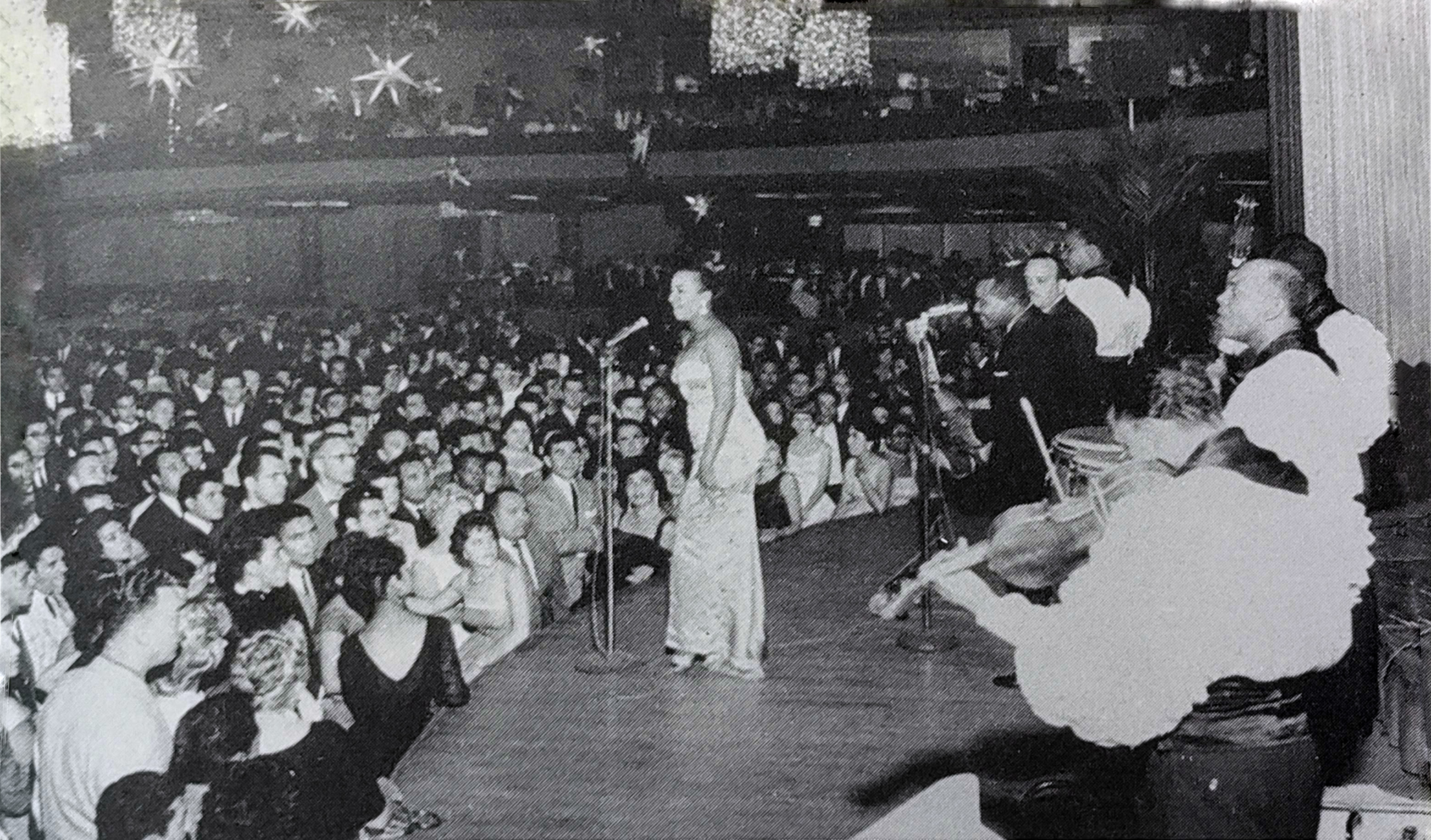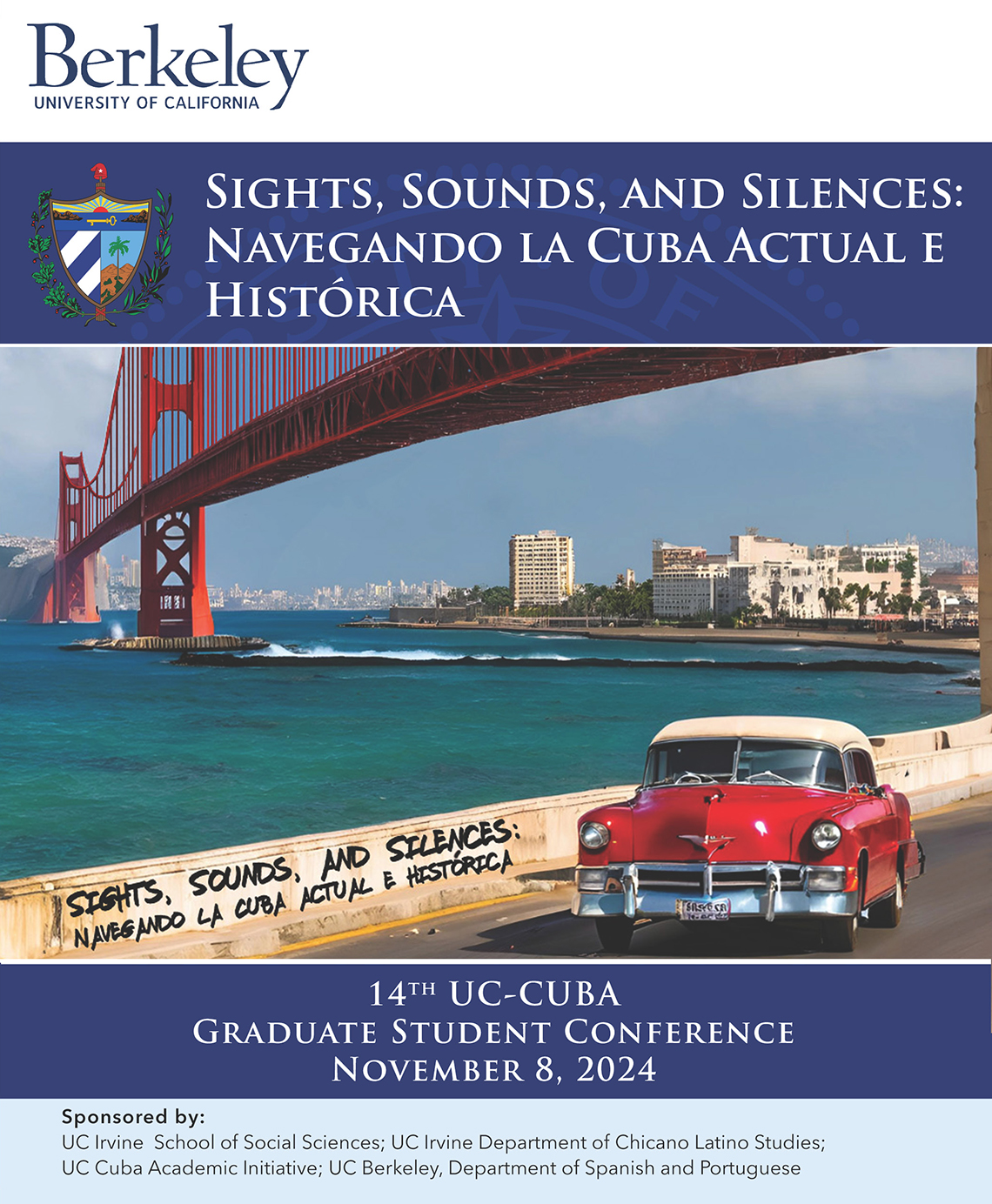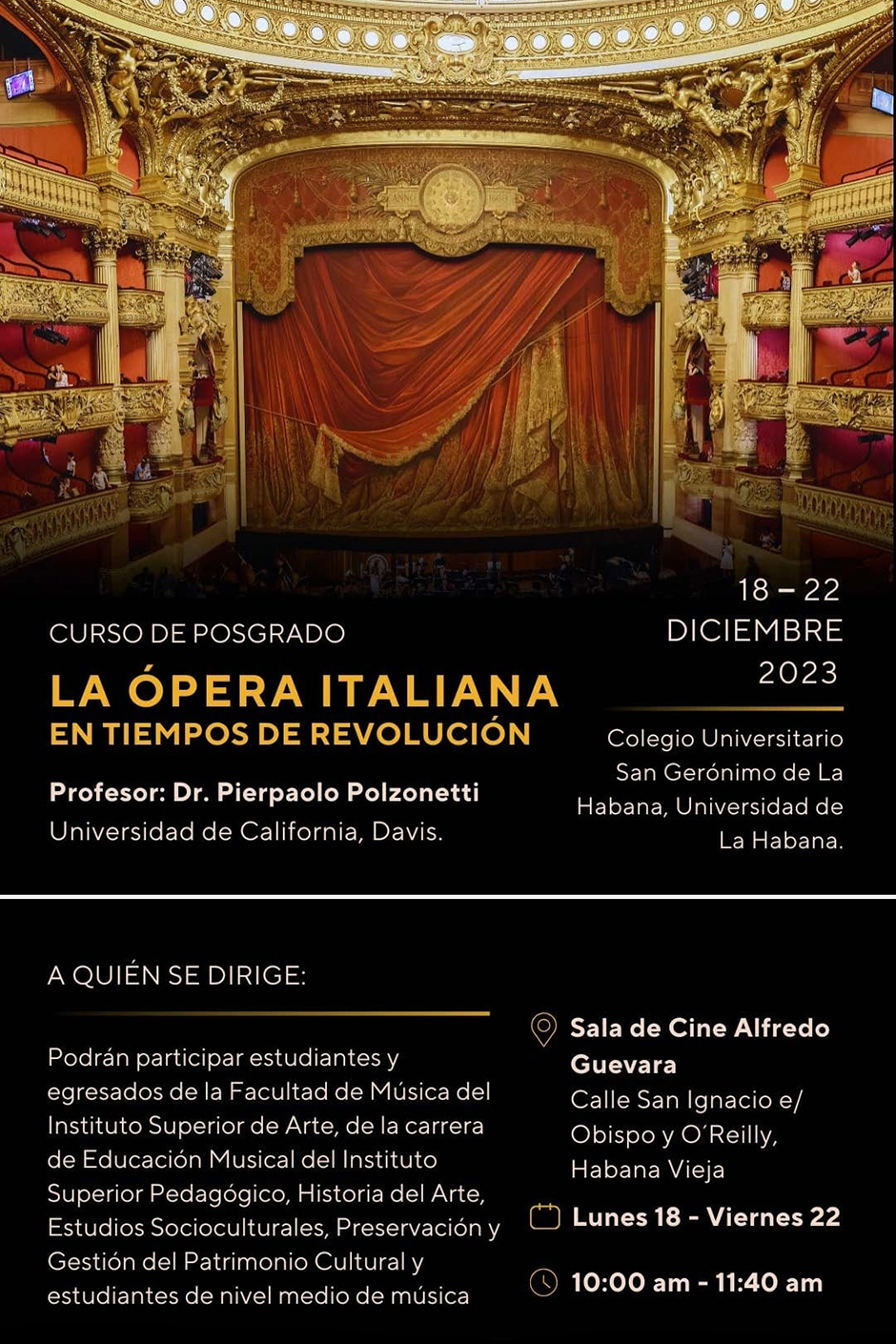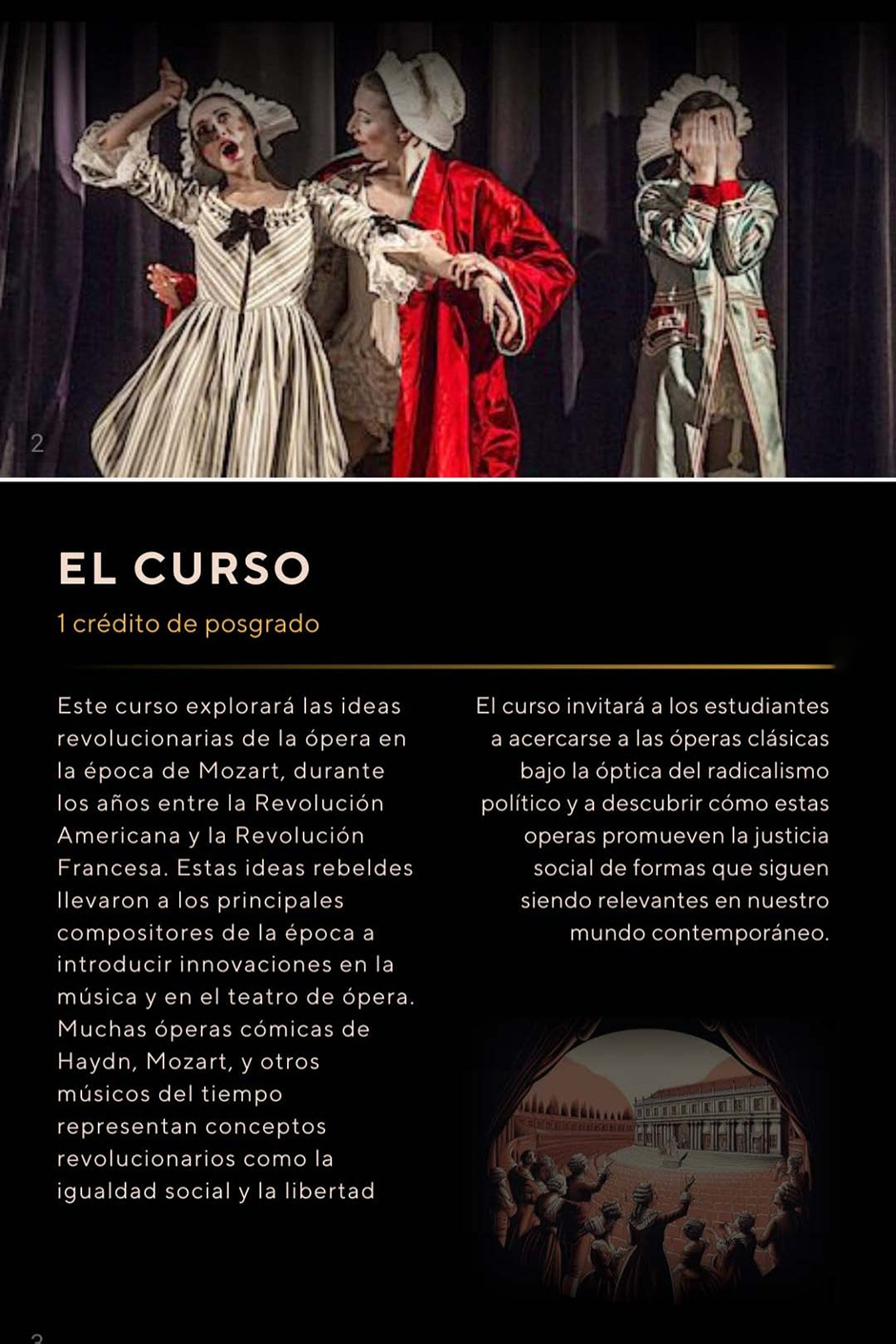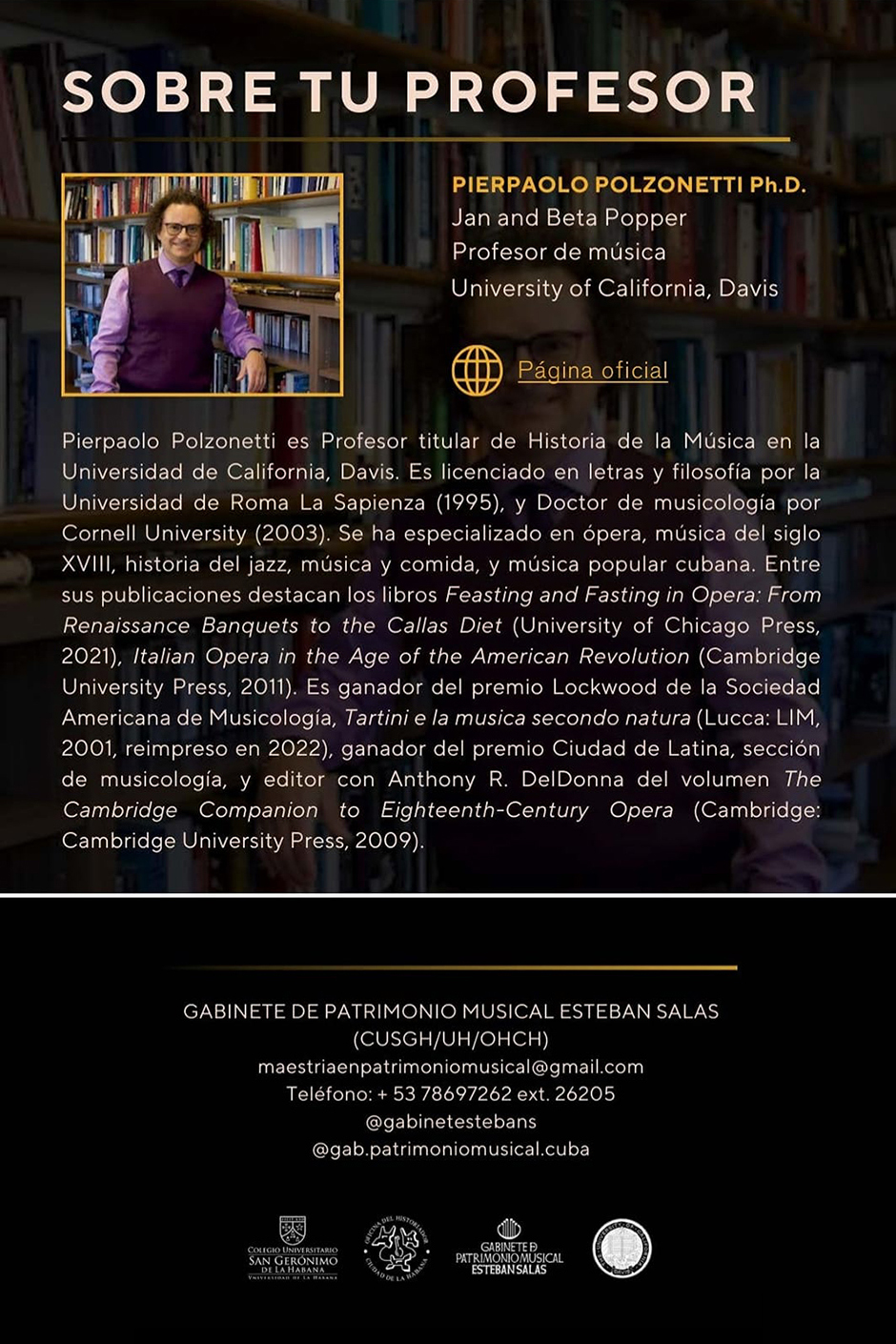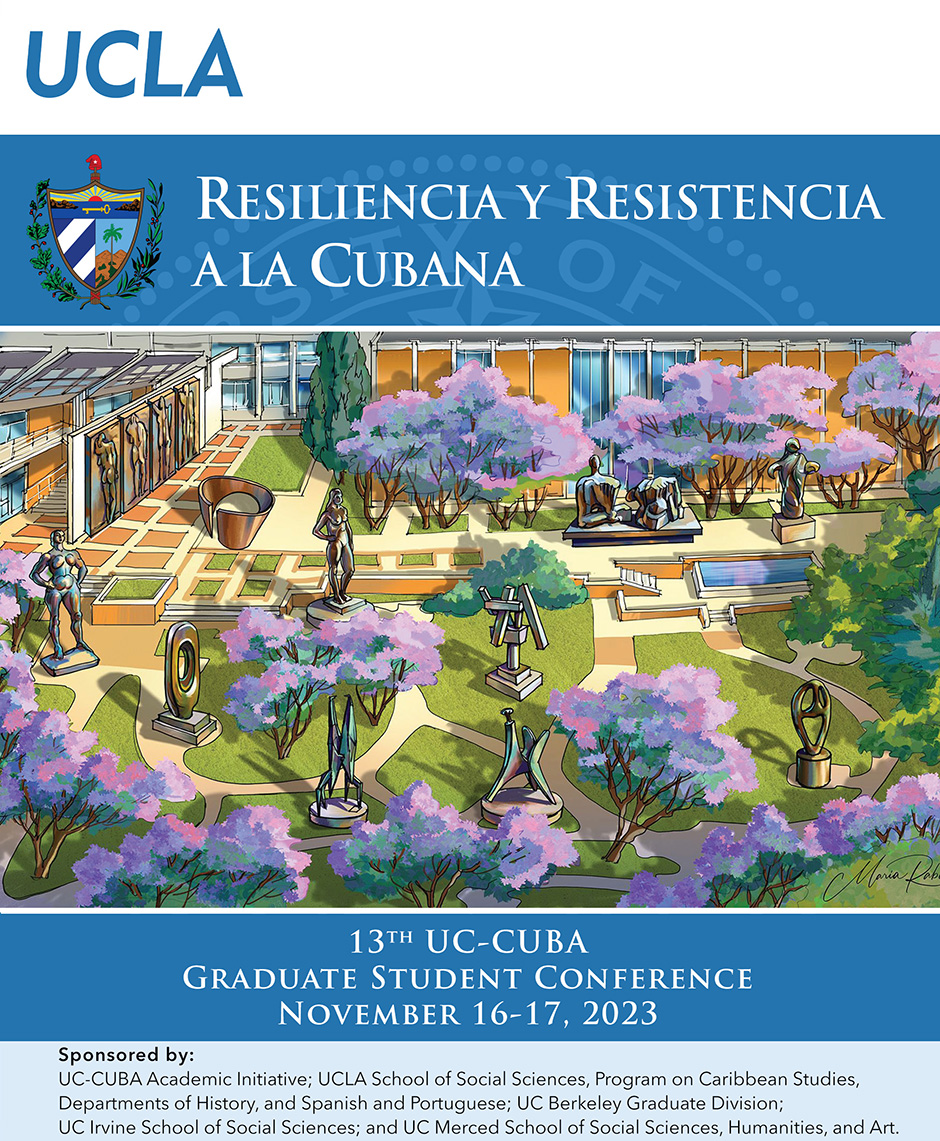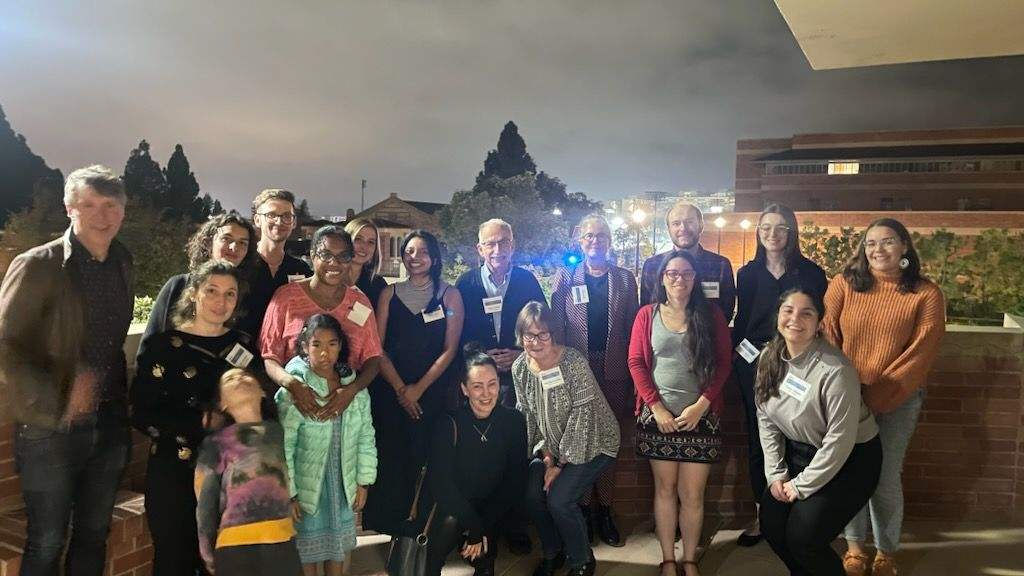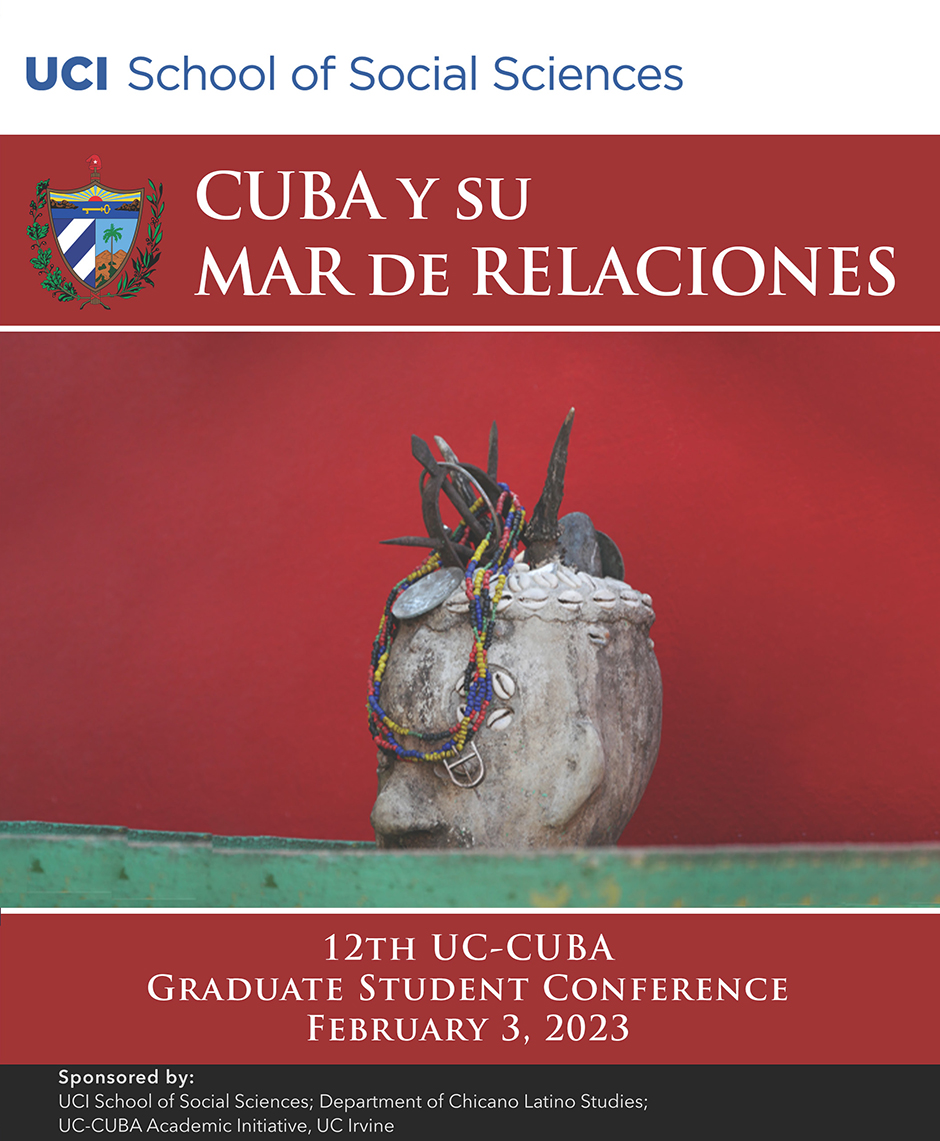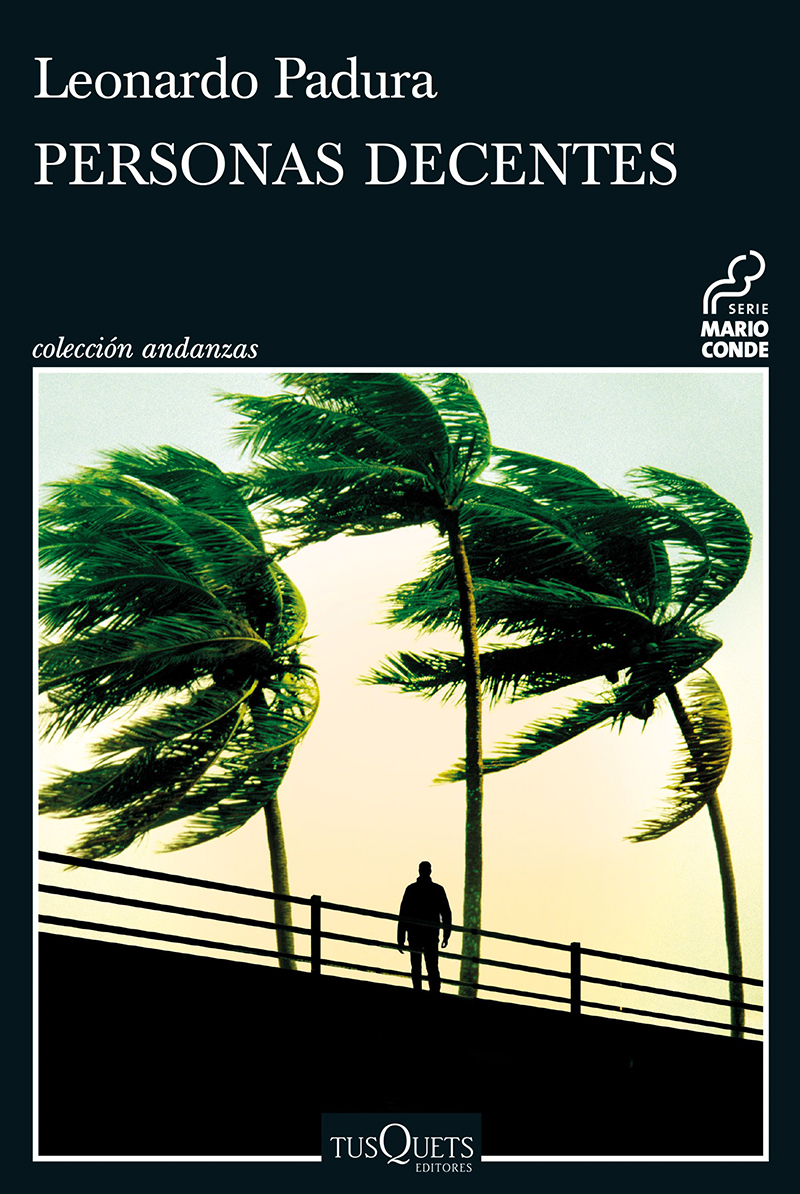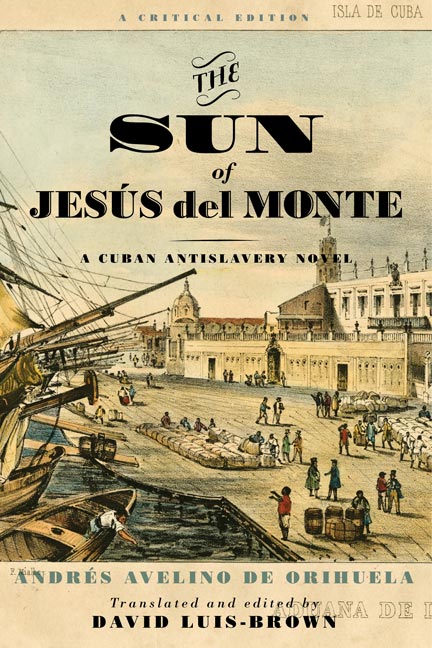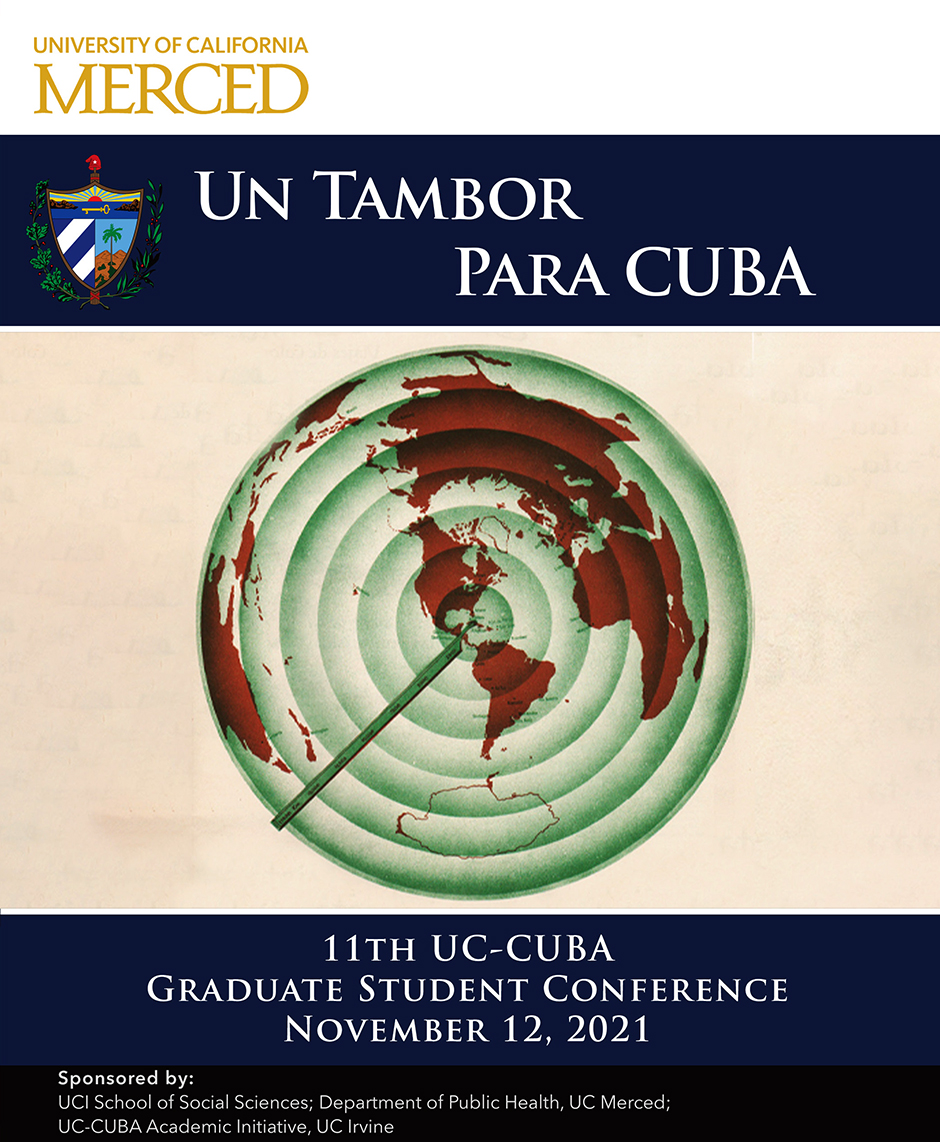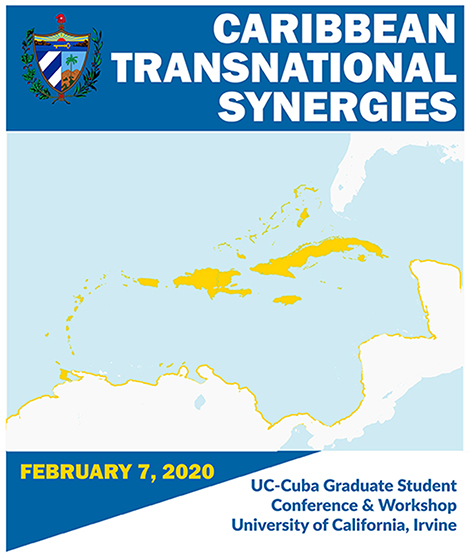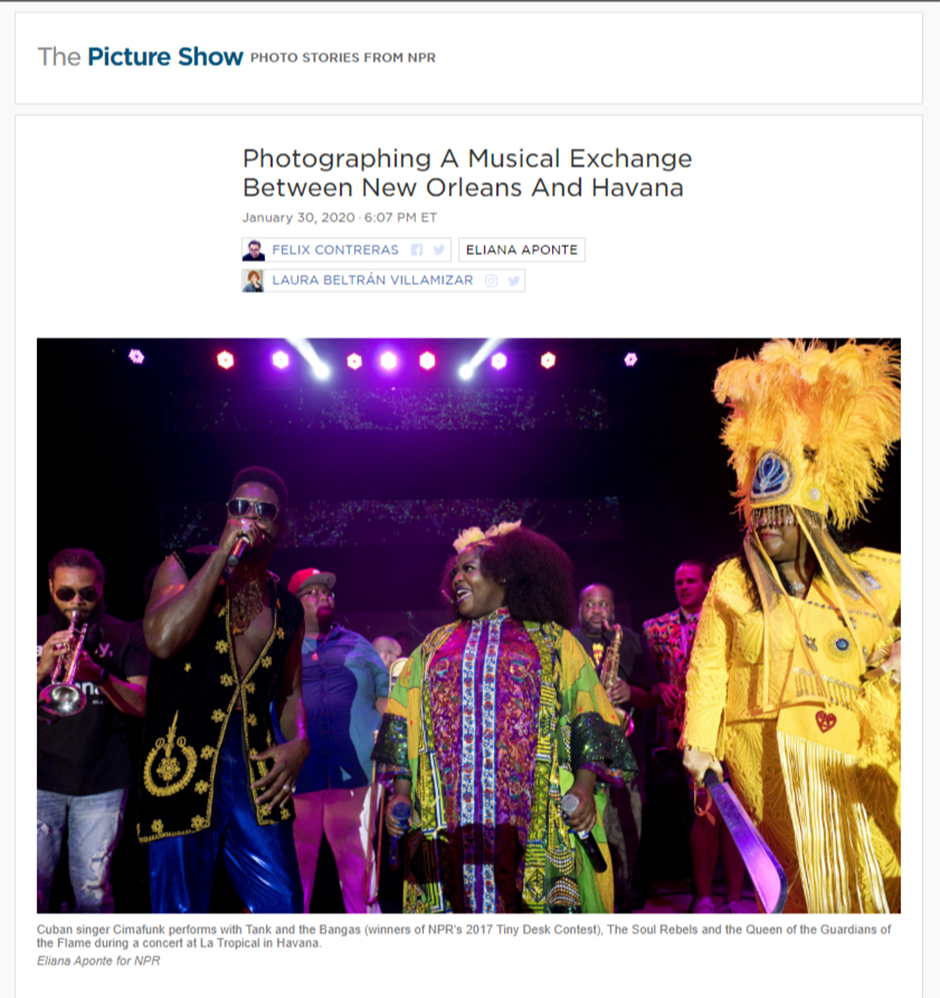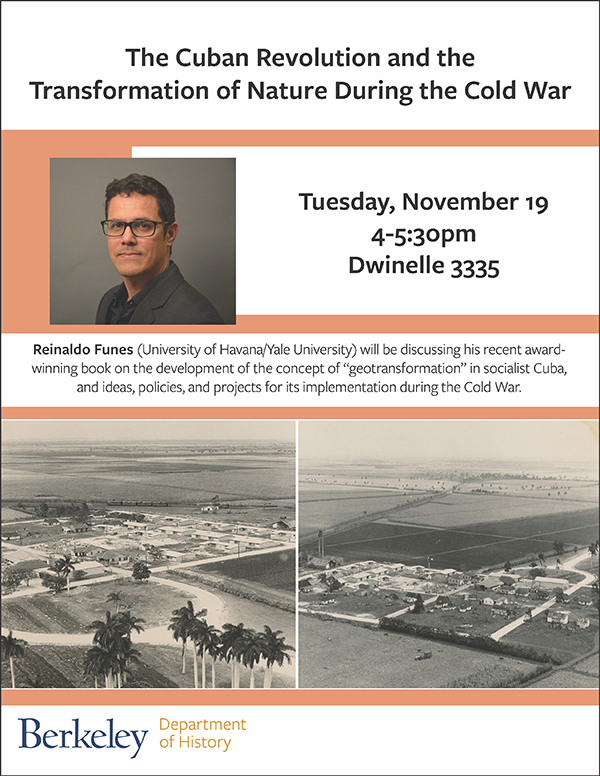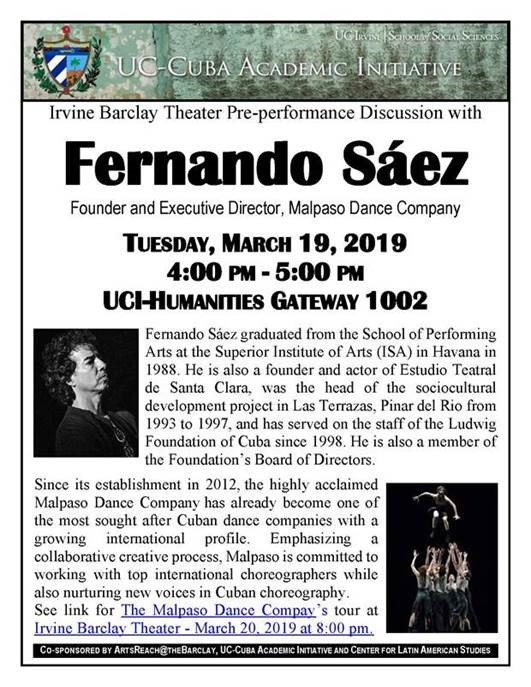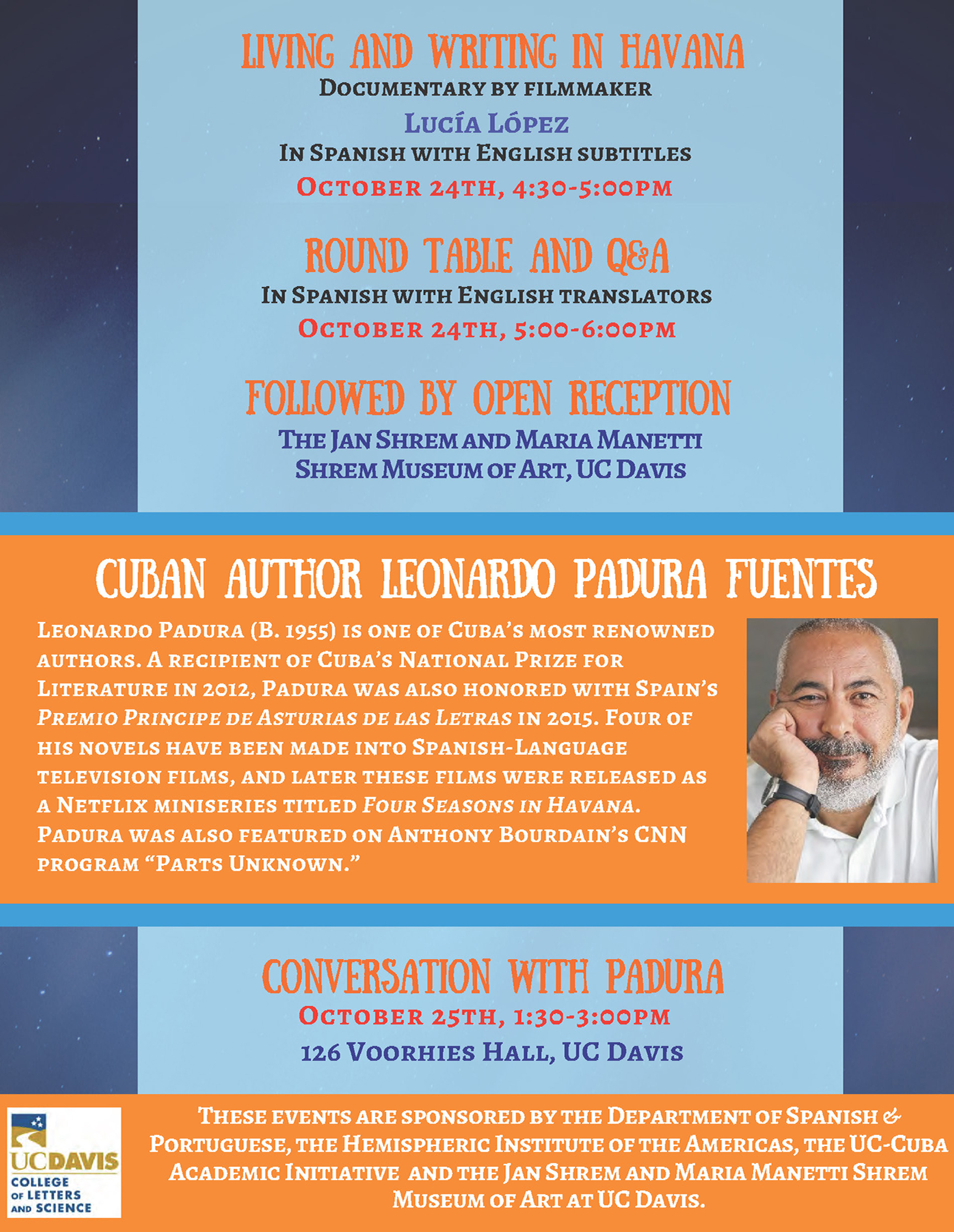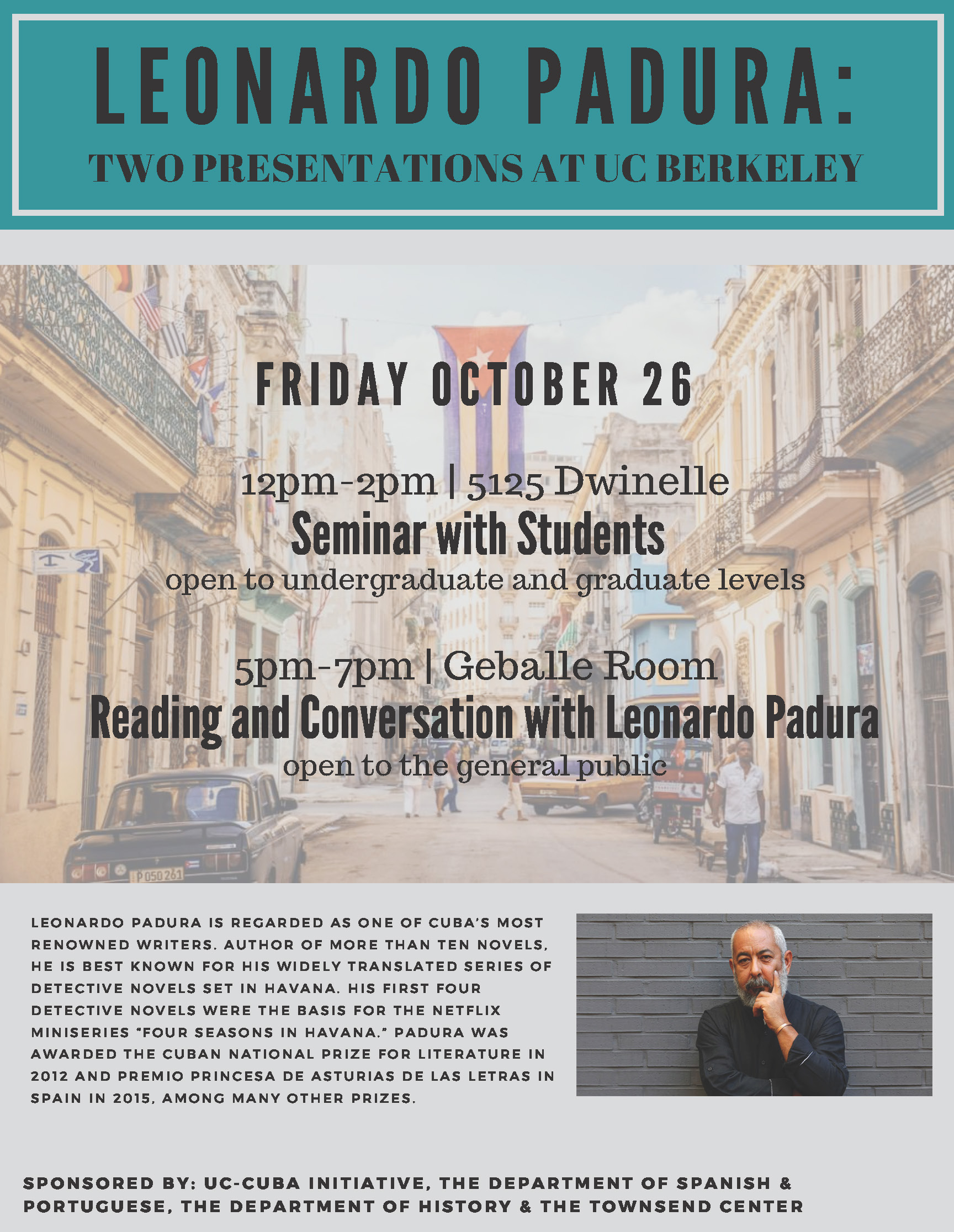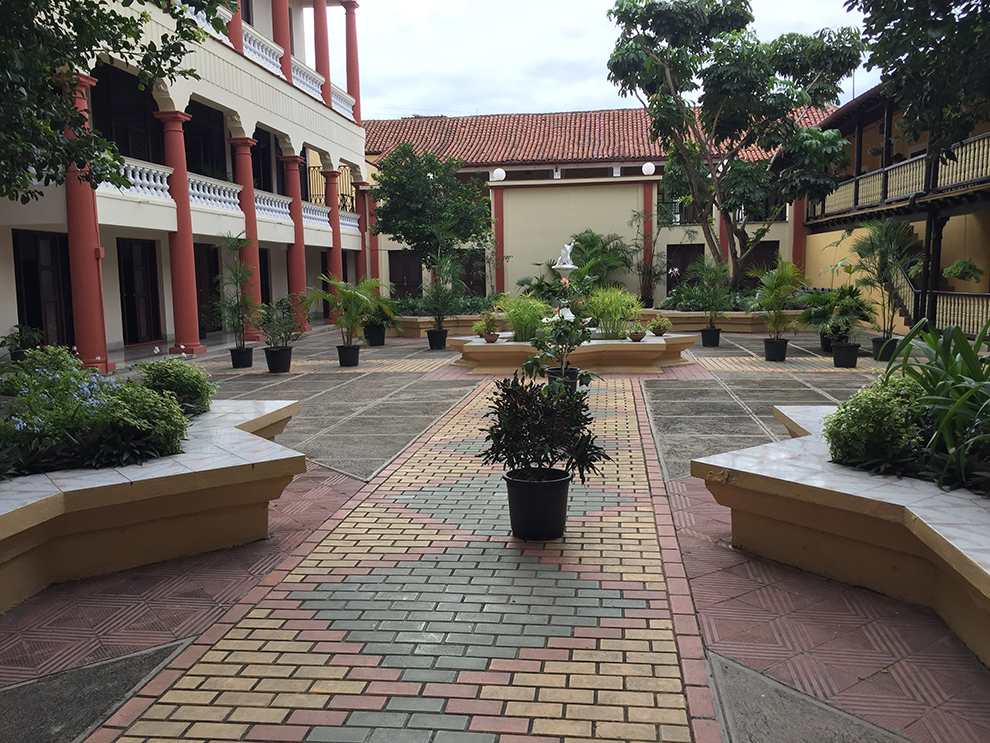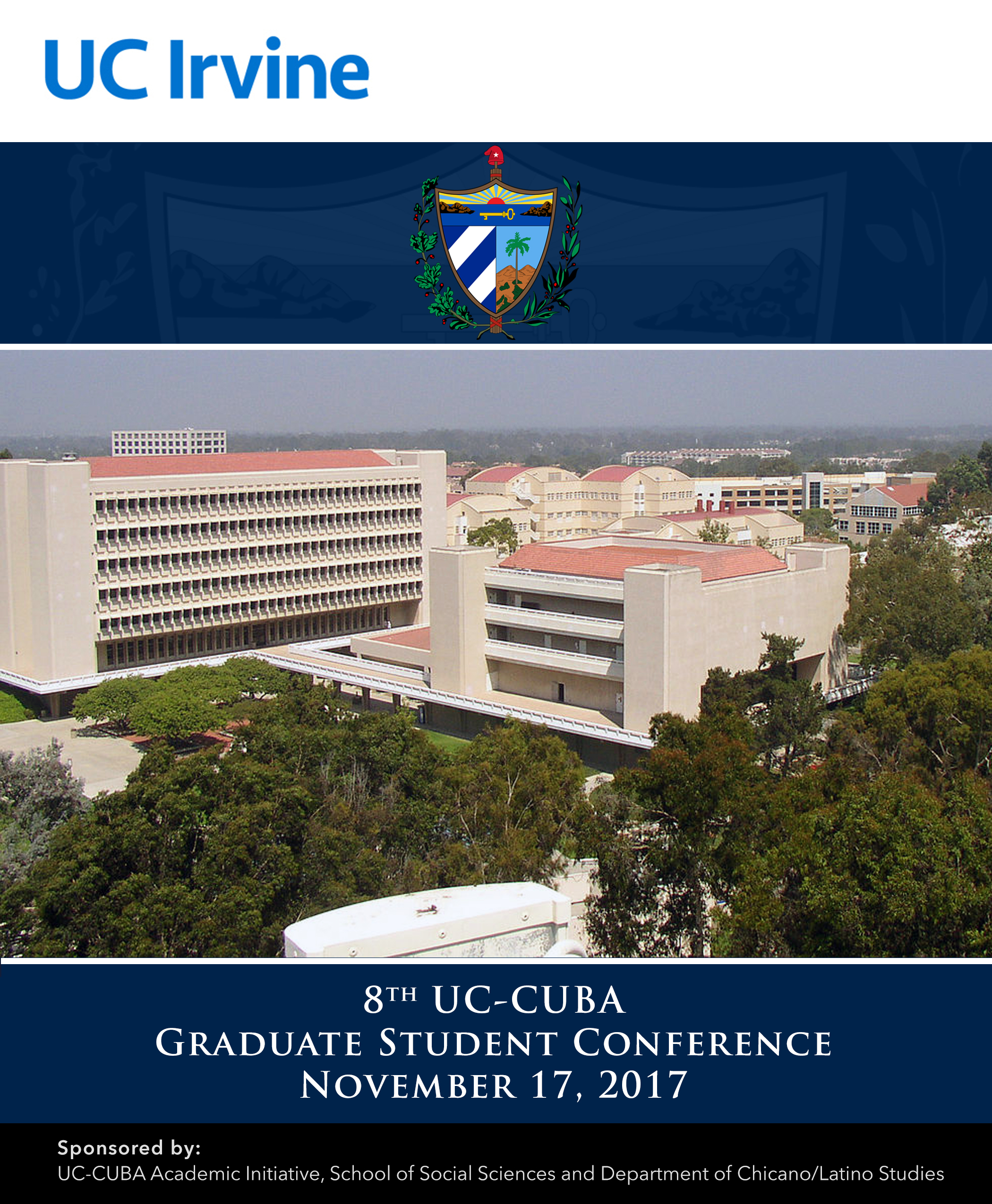Introduction
In 2006, professors from nine University of California campuses came together to create the UC-CUBA Multi-Campus Academic Initiative.
Headquartered at UC Irvine, UC-Cuba has grown since then into a diverse and thriving
international network of university faculty, graduate students, and independent scholars,
united by their shared passion for all things Cuban.
Latest News & Events
15th UC-CUBA Graduate Student Conference - Raices y Rutas: Remapping Cuba from Within and Beyond | November 13-14, 2025
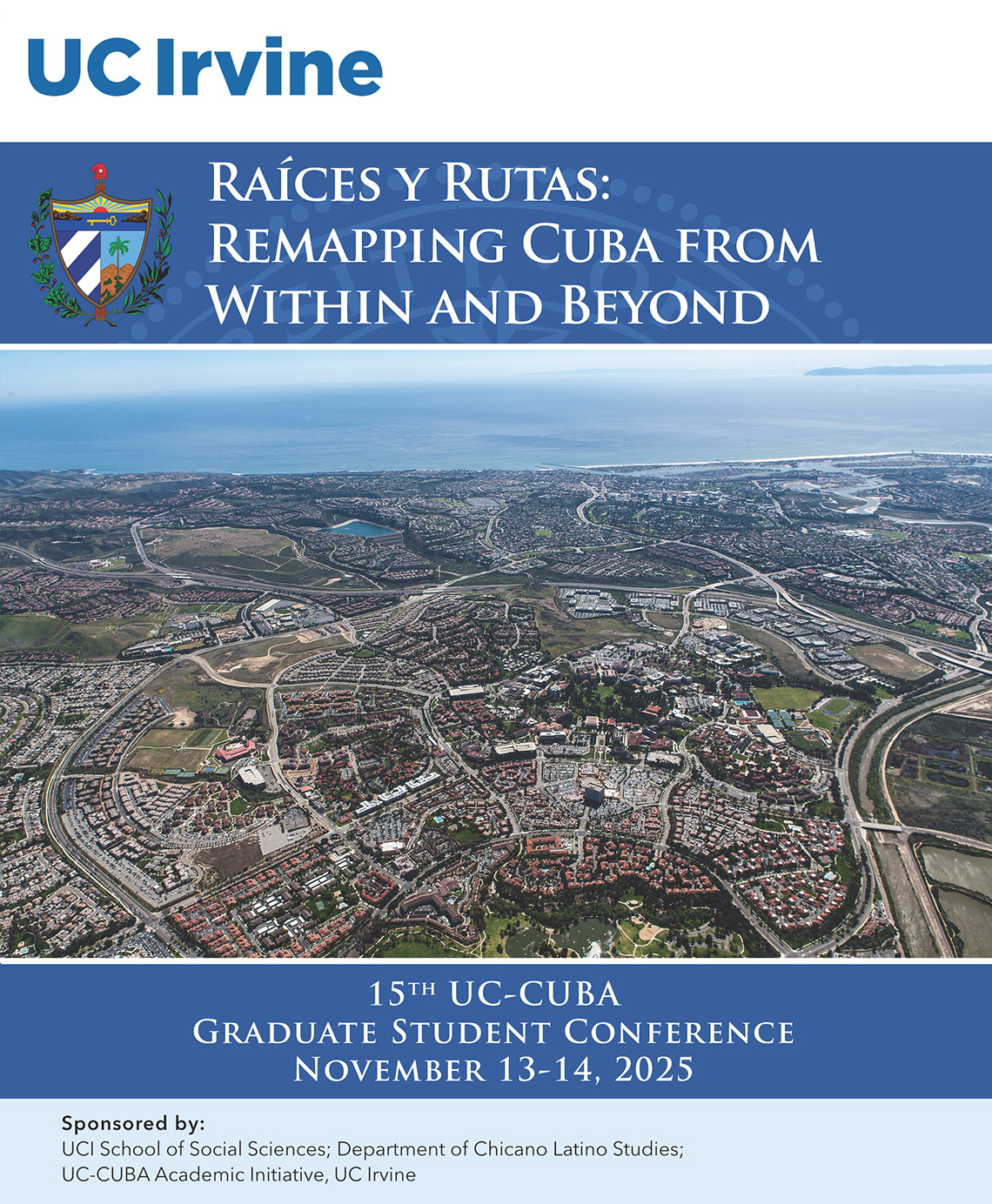
Download a copy of the Program
-
Castillo del Morro, Santiago de Cuba
Castillo del Morro, Santiago de Cuba
 Overlooking the Santiago de Cuba Bay the Castillo de San Pedro de la Roca is a UNESCO
World Heritage Site. Designed by the Italian engineer Juan Battista Antonelli, who
also designed similar fortresses in San Juan (Puerto Rico), Cartagena de Indias, and
Havana, the San Pedro Castle is considered the best preserved and most complete example
of Spanish military architecture in the Americas.
Overlooking the Santiago de Cuba Bay the Castillo de San Pedro de la Roca is a UNESCO
World Heritage Site. Designed by the Italian engineer Juan Battista Antonelli, who
also designed similar fortresses in San Juan (Puerto Rico), Cartagena de Indias, and
Havana, the San Pedro Castle is considered the best preserved and most complete example
of Spanish military architecture in the Americas. -
A great Cuban musician passed away: Rolando Lozano (1931-2025)
A great Cuban musician passed away: Rolando Lozano (1931-2025)
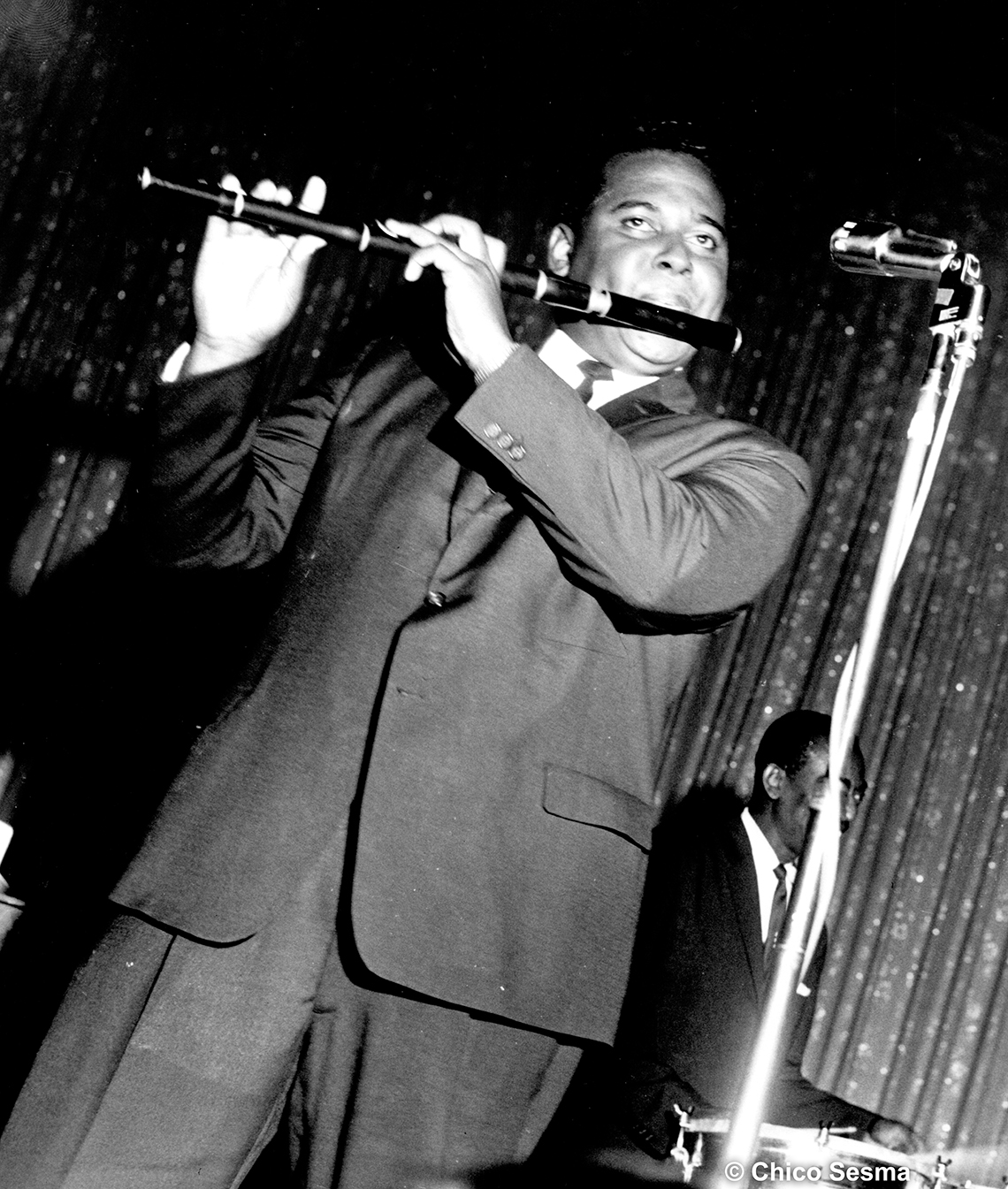 A renowned Latin Jazz musician, the great flute player Rolando Lozano, passed away
May 19 at the age of 94. Lozano began his professional career in Cuba in the late
1940s and early 1950s as flutist in the Cuban Orquesta Aragón, a Cienfuegos-based
famous charanga band. The charanga is a Cuban ensemble made up of flute, violins,
double bass, piano, timbales, güiro and vocals. Charangas performed Cuban music in
the early 20th century and became prominent with the rise of cha-cha-cha in the 1950s. Lozano was
featured in some of the early hits that launched Aragón to national fame including
“Pare cochero, ” “Tres lindas cubanas,” and “Agua de clavelito. ” This was the era
when neighborhood dance club societies like Galatea, Havana Sport and the now famous
Buena Vista Social Club were still in operation.
A renowned Latin Jazz musician, the great flute player Rolando Lozano, passed away
May 19 at the age of 94. Lozano began his professional career in Cuba in the late
1940s and early 1950s as flutist in the Cuban Orquesta Aragón, a Cienfuegos-based
famous charanga band. The charanga is a Cuban ensemble made up of flute, violins,
double bass, piano, timbales, güiro and vocals. Charangas performed Cuban music in
the early 20th century and became prominent with the rise of cha-cha-cha in the 1950s. Lozano was
featured in some of the early hits that launched Aragón to national fame including
“Pare cochero, ” “Tres lindas cubanas,” and “Agua de clavelito. ” This was the era
when neighborhood dance club societies like Galatea, Havana Sport and the now famous
Buena Vista Social Club were still in operation.Lozano was a multi-instrumentalist who played piano, clarinet and flute. A master of the five-key flute, Lozano possessed a full, round sound, playing easily in the high keys. He “lived in the stratosphere,” in the words of another fabulous flutist, Professor of Music at Whittier College, and two-time Grammy Award Flutist, Rolando’s son Danilo. Rolando Lozano used catchy street rhythmic phrases in his inspirations. His loud “pitazos” (sharp rhythmic flute bursts) became synonymous with the sound of the Aragon. Listening to Lozano was like hearing the call of a quinto drum in a street rumba ensemble.
After the stint with Aragón, Lozano relocated to México in 1954 where he played with Mondéjar’s Orquesta América and his sound can be heard in five emblematic exotic rumbera films including Club de señoritas and Las viudas del chachachá, starring vedette Ninón Sevilla. In 1957 Lozano moved first to Chicago, and then Los Angeles and began a career as a Latin Jazz musician centered on the West Coast. He played his five-key flute in George Shearing’s Latin Satin, Latin Lace, and Latin Rendezvous albums and recorded with Cal Tjader the LP Latino. Lozano was key in the development of the charanga tradition in the United States. He helped form the first charanga in the United States, the Orquesta Nuevo Ritmo, which accompanied Celia Cruz’ first performance in Los Angeles in 1959. La Nuevo Ritmo became La Sabrosa when Mongo Santamaría, who called Lozano “the best Cuban flautista in the United States,” took over as band leader in 1962. After settling in the Boyle Heights barrio of Los Angeles, Lozano led another charanga, the Típica Antillana, in Los Angeles; played alto sax (!) with the René Bloch Big Band; recorded with Tito Puente and Francisco Aguabella and played piano at various nightspots in the city.
Requiescat in pace maestro de la flauta Rolando Lozano!
You can appreciate Lozano’s ‘stratospheric’ sound in Cal Tjader’s recording of “El continental” from the album Latino.
-
A Historian Visits Cuba
A Historian Visits Cuba
by Tanalís Paddilla
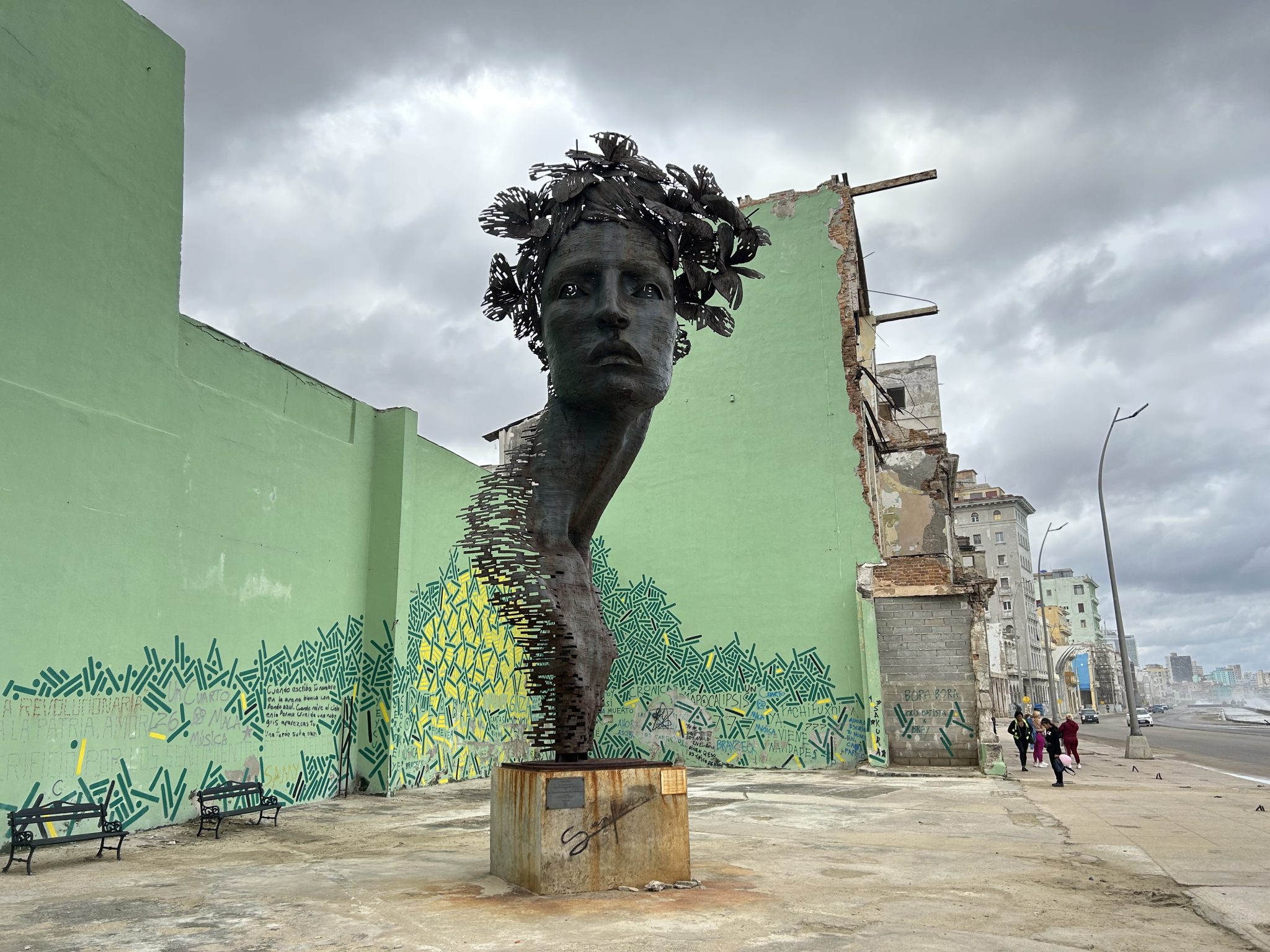
Photo by Tanalís Paddilla As an historian of Latin America, my work long focused on México, the country of my birth and the place where I spent my childhood. After completing my second monograph however, I began a research project on Cuban medical internationalism, an effort to understand the significance of the over 600,000 doctors Cuba has sent to treat patients in 165 countries over the past 60 years. As part of my research, I spent this past January in Cuba, visiting hospitals, speaking to doctors, clinicians and medical professors, and reading bound, dusty newspapers whose fraying edges left a visible trail of my work on the table and floor of the National Library.
When not working, I spent much of my time exploring the city on foot, an activity especially pleasant in January when temperatures hardly creep above the mid-70s. My meandering walks took me from Vedado, the tree-lined residential neighborhood where I stayed, through the thickly populated center of Havana where 1980s-model Russian cars, almendrones (1950s Chevies used for collective transport) and electric scooters speed by. As one approaches old Havana, the colonial architecture, bright colors, cobblestone streets and souvenir shops are not unlike other Latin American cities. But Havana’s music, food, and ocean breeze are distinctly Caribbean. There is a vibrancy, warmth and joy to the environment, even as there are some notably empty establishments, visible signs of a tourist industry that has not recovered from pre-pandemic levels.
My favorite part of these long, meandering walks was returning by way of the malecón, the walkway that runs along the water where the restless ocean pounds the stone wall, at times producing dramatic waves that crest several feet in the air and drench sidewalk, street, and anyone along them.
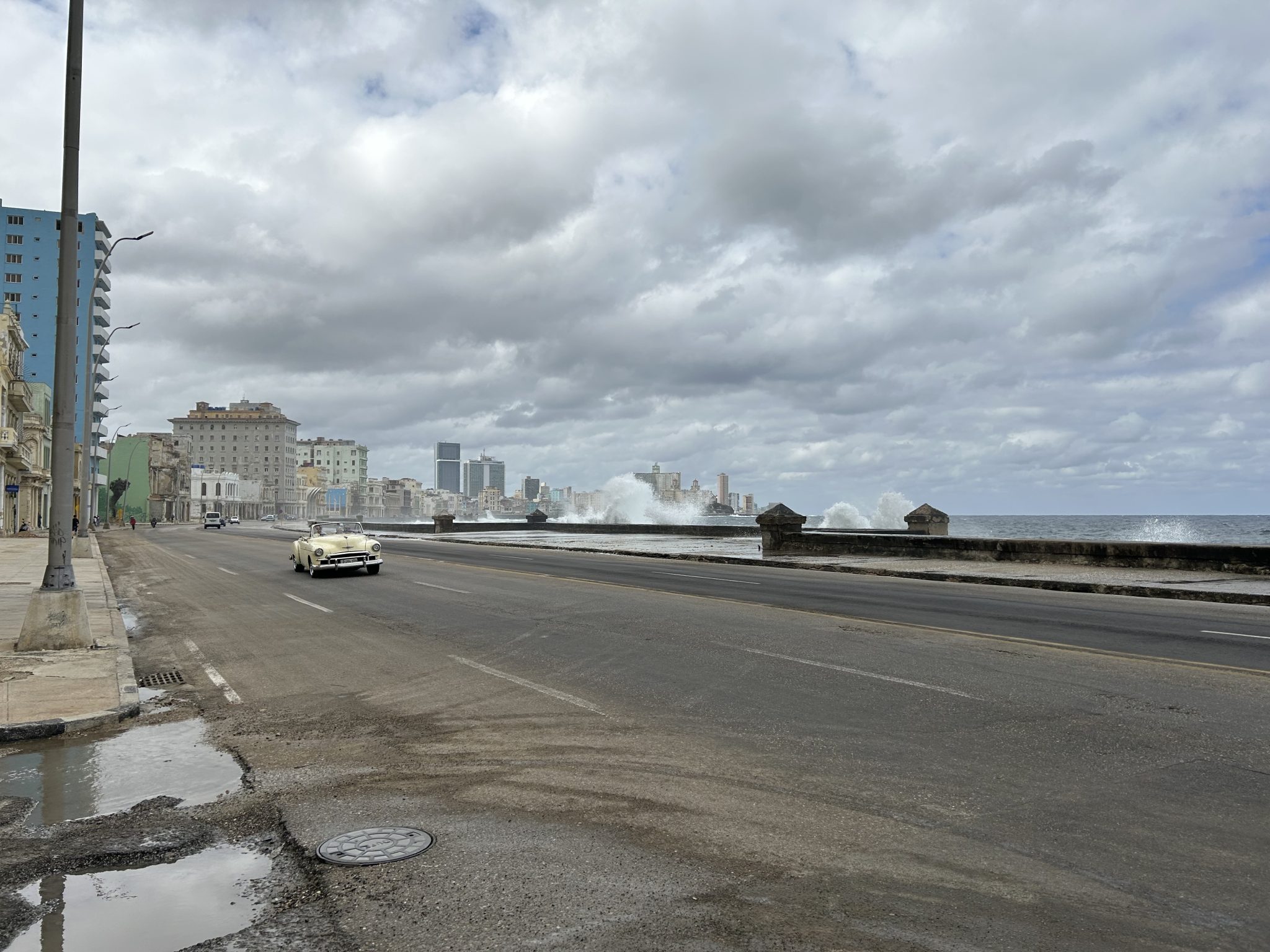
The Malecón - Photo by Tanalís Paddilla I’m tempted to say that it was the sound of the ocean that made these walks therapeutic. In some ways it was. But more than that, it was the utter lack of commercial advertising that, these days, is unheard of in urban spaces. The overpowering flashing lights and billboards, the scripted, ebullient voices on screens and speakers selling you a lifestyle you won’t achieve or a product you don’t need, the towering malls now ubiquitous in our modern world, are absent in Cuba. It is a welcome respite for the soul and the senses.
Cuba is not, as some may claim, a land frozen in time – despite the 1950s Chevrolets that have become such an iconic representation of Havana imagery. As in other places, there are people glued to their cell phones, electric vehicles occasionally whiz by, and the towering hotel buildings are indistinguishable from those in other tourist sites. But there is a precarity and simplicity to the way things are done, one that puts in sharp relief the wasteful nature of our lifestyle in the land of plenty. Cuba, according to some studies, ranks among the top 10 nations in the sustainable development index as it has a high human development with a low ecological footprint.
The island’s current economic crisis threatens this high human development. The signs of hard times are everywhere: high food prices, long fuel lines, empty pharmacy shelves, blackouts, and infrastructure in visible disarray. Daily life is hard, very hard, people tell you. Triggered by the pandemic which shut down tourism – a key source of capital – and locked in place by a barrage of sanctions imposed by the first Trump administration (and maintained by Biden) the Cuban economy has been unable to recover. People spoke to me openly, and, in typical Cuban fashion, passionately, about the difficulties of the current moment. Perspectives came from across the political spectrum: from those wholly dissatisfied with their government, to those expressing constructive criticism, to those hailing the revolutionary project. Not a single one of them thought their situation would improve through continued Washington-based sanctions. On the contrary, all anticipated even harsher times knowing the incoming administration would harden US policy towards Cuba. This reality was quickly born out when, on day one, Trump overturned Biden’s last-minute removal of Cuba from the US-designated State Sponsor of Terrorism list. Secretary of State Marco Rubio’s new measures prohibit Western Union from processing wire transfers to Cuba and sanction officials in other countries who collaborate with the island’s international medical missions.
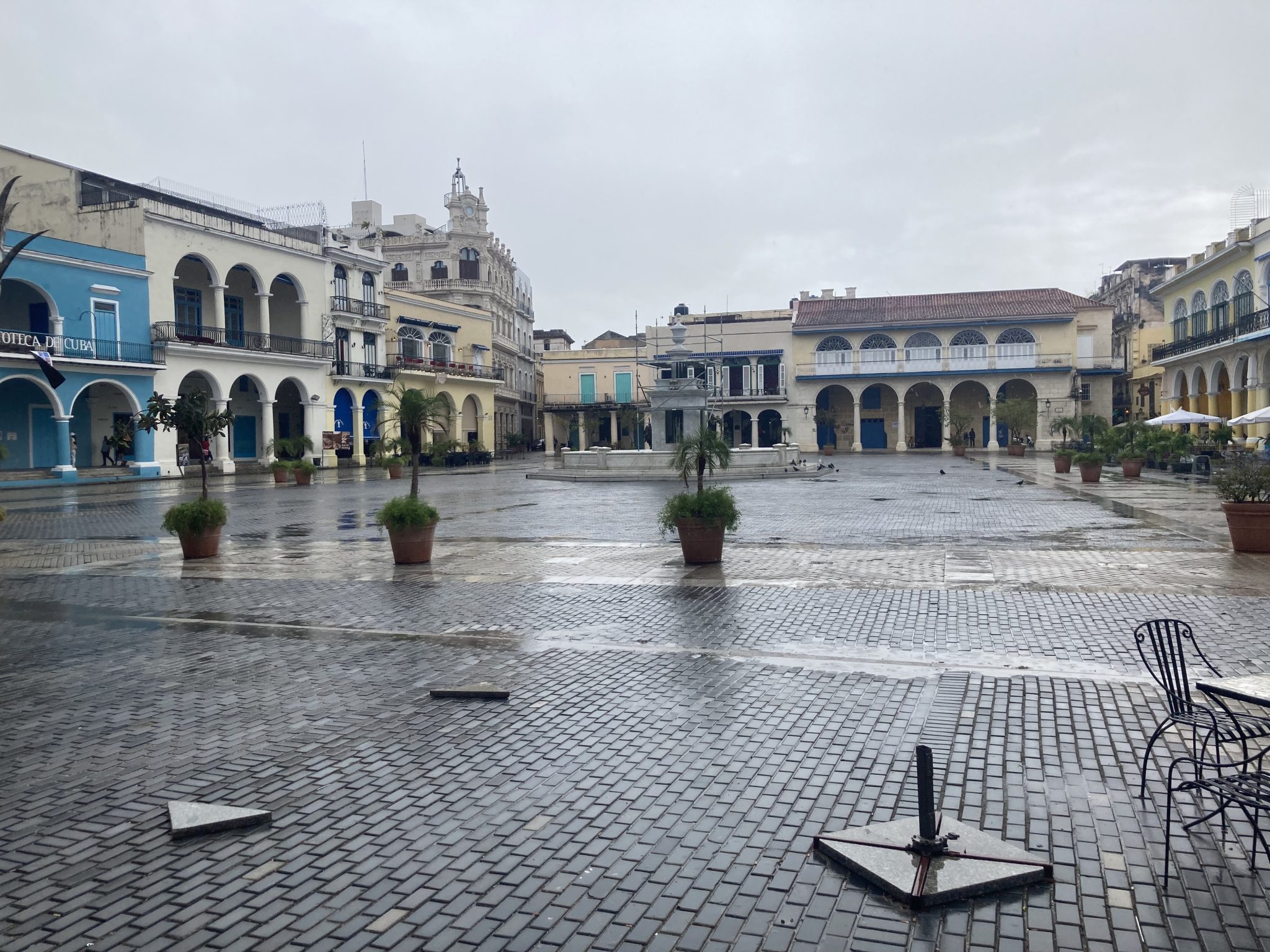
Old Havana - Photo by Tanalís Paddilla In the context of such difficulties, it was moving to experience the annual Marcha de las antorchas (The March of the Torches), a visually striking and joyful celebration of the birth of José Martí, the poet, essayist, journalist, children’s writer, and revolutionary who died on the battleground fighting for independence from Spain in the 1890s. During his lifetime, Martí traveled the American continent (north and south) denouncing colonial domination, warning of the threat of imperialism and urging for a multi-racial coalition to fight for self-determination.
Every year, on January 27th thousands gather in the late afternoon at the University of Havana to honor Martí’s memory and celebrate his example. By the time dusk takes hold, the university steps and the street to which its passage descends, is spilling over with students, families, and contingencies from various organizations. Music playing on loudspeakers adds to the festive mood. Many come with their own makeshift torches – an empty food can with a flammable cloth atop a wooden stick – but most pick these up from the vast piles already there. I was told that in the days leading up to the march youngsters across school grades are charged with bringing one such homemade torch, which are then gathered and handed out to attendees. Knowing from the previous year’s celebration how crowded the event gets, I arrived early to secure a good spot. Coincidentally, as in the previous year, I found myself next to the contingency from the Latin American School of Medicine, the 25-year-old medical school that has graduated thousands of doctors from the global south. These international students carried flags from their homelands – including Palestine – a way to honor, I thought, Martí’s internationalist yearnings. Once darkness fell and student leaders had pronounced some brief speeches, a specified signal began the lighting of the torches. The line of fire gradually grew into a stunning orange river of lights flowing along the designated avenue and winding its way to malecón.
The following day, next to the National Library where I conducted my daily archival work, Martí’s commemoration had children at its center. The spectacle of lights of the previous night was matched by a spectacle of color as elementary and junior high school students who, in their iconic red and blue uniforms carried flags, flowers, and wreaths to the towering statue of Martí in the Plaza of the Revolution. This vast, open space is Cuba’s administrative center and the surrounding government buildings have giant steel murals of revolutionary heroes Ernesto Che Guevara and Camilo Cienfuegos.
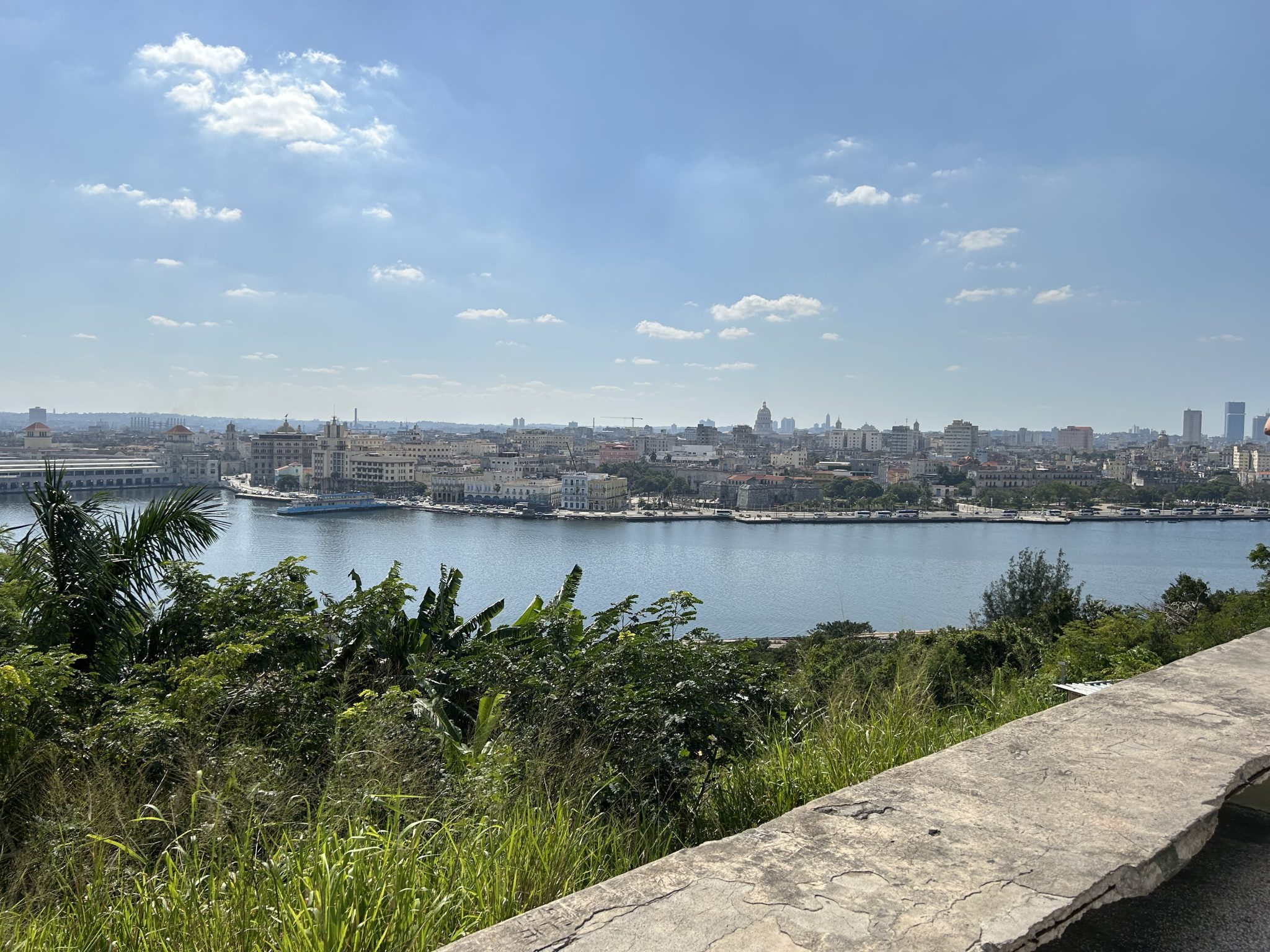
Across the Bay - Photo by Tanalís Paddilla On my last day in Havana, a taxi driver, astounded by how much time I had spent doing “library work” and had seen next to none of the attractions he listed off, urged me to at least let him take me to the Christ of Havana. Dismayed, once again, that I did not know what that was, he explained that it was a statue located on a hilltop across the bay that would give me the most beautiful view of the city. Once across the water, the panoramic view – its historic fortress, capital building, hotels and malecón, all against a clear blue sky – indeed proved stunning. “Oh, and by the way,” he commented as we arrived at the hilltop, “that’s Che Guevara’s house over there.” The residence of the guerrilla leader and former economic minister had been turned into a museum where visitors could see the office where he met with dignitaries; as well as view numerous historical artifacts, and read an account of his expeditions.
I conversed at length with the driver about México, about the US, about the difficult times in Cuba. “But there’s no violence here,” he kept emphasizing. Indeed, amid otherwise woeful outlooks, this fact emerged time and again in different ways. When I reflect on my visits there, that fact, along with the absence of pervasive advertising, stand out. The lack of violence in the island allows for acts unthinkable in other parts of the Americas, like walking alone at night or having children play outdoors without supervision.
Such public safety has held despite the current crisis. While there has been an increase in petty theft, violence as we know it in the rest of the Americas, including the US, is non-existent. When interviewing Cuban doctors, one of the experiences they recount is the novelty of treating gunshot wounds abroad, “It’s just something you don’t have in Cuba,” they explain.
Heading back to the taxi from the Che Museum the driver and I walked across a small park. A man sleeping on a bench would probably have remained unnoticed by both of us but for the fact that the parking attendant was running toward him and shouting something with a sense of urgency. I assumed, of course, it was to reprimand him for making a public bench his resting place. Instead, the guard alerted him to the fact that his glasses were sliding down his face and would break if they hit the floor. The driver and I chuckled as he said to me, “Imagine if this were Mexico or the US, they’d haul the guy off – bench and all!”
-
Documentary by Professor Pierpaolo in Havana
Documentary by Professor Pierpaolo in Havana
Professor Pierpaolo Polzonetti’s documentary “El Sabroso” was shown at the Colegio San Gerónimo in Havana on February 13. El Colegio San Gerónimo, a college of the University of Havana, is focused on the preservation of Cuba's traditional cultural heritage.
The event began with a few words by Pierpaolo, followed by a couple of tunes by the Son Cuba, to which Adel Núñez’ widow Barbara and her dancing partner Luis Felipe danced. Along with her nene. :) Then the documentary was shown. It ended with standing applause and some tears. The Septeto Habanero played traditional sones, and a local “repentista” improvised décimas in honor of Adel Núñez. UC-CUBA was represented, in addition of course by Pierpaolo himself, by doctoral candidates Isabel James (Geography, UCLA) and Allison Baker (History, UCSD) in addition to Elba Capote. The three of them as well as Pierpaolo provided the attached pictures.
-
CUBA Travel Report 2024
CUBA Travel Report 2024
From Dec 7-14 I traveled to Havana accompanied and assisted by my daughter Marisa Santangelo as part of UC-CUBA’s engagement with Cuban cultural and educational institutions. As always, we received the support of our collaborators on the ground Elba Capote, Marina Rodríguez and Tony Pérez. Isabel James joined us in some of our ‘rounds’. The highlight of the week was meeting and watching a performance by Barbara Morales, the widow of Adel “El sabroso,” the fabulous late tresero featured in our colleague Pierpaolo Polzonetti’s soon-to-be released documentary. Below is a recount of our itinerary. Relevant photos attached.
Sunday Dec 8: We visited the Colon Cemetery on the anniversary of Wifredo Lam’s birth in 1902 and witnessed the small, yearly visit to his gravestone by artists and relatives.
We also paid a visit to Isabel Gonz´lez, who is working on a new edition of the Diccionario enciclopédico de la música en Cuba, the important reference work edited by her late husband Radamés Giro.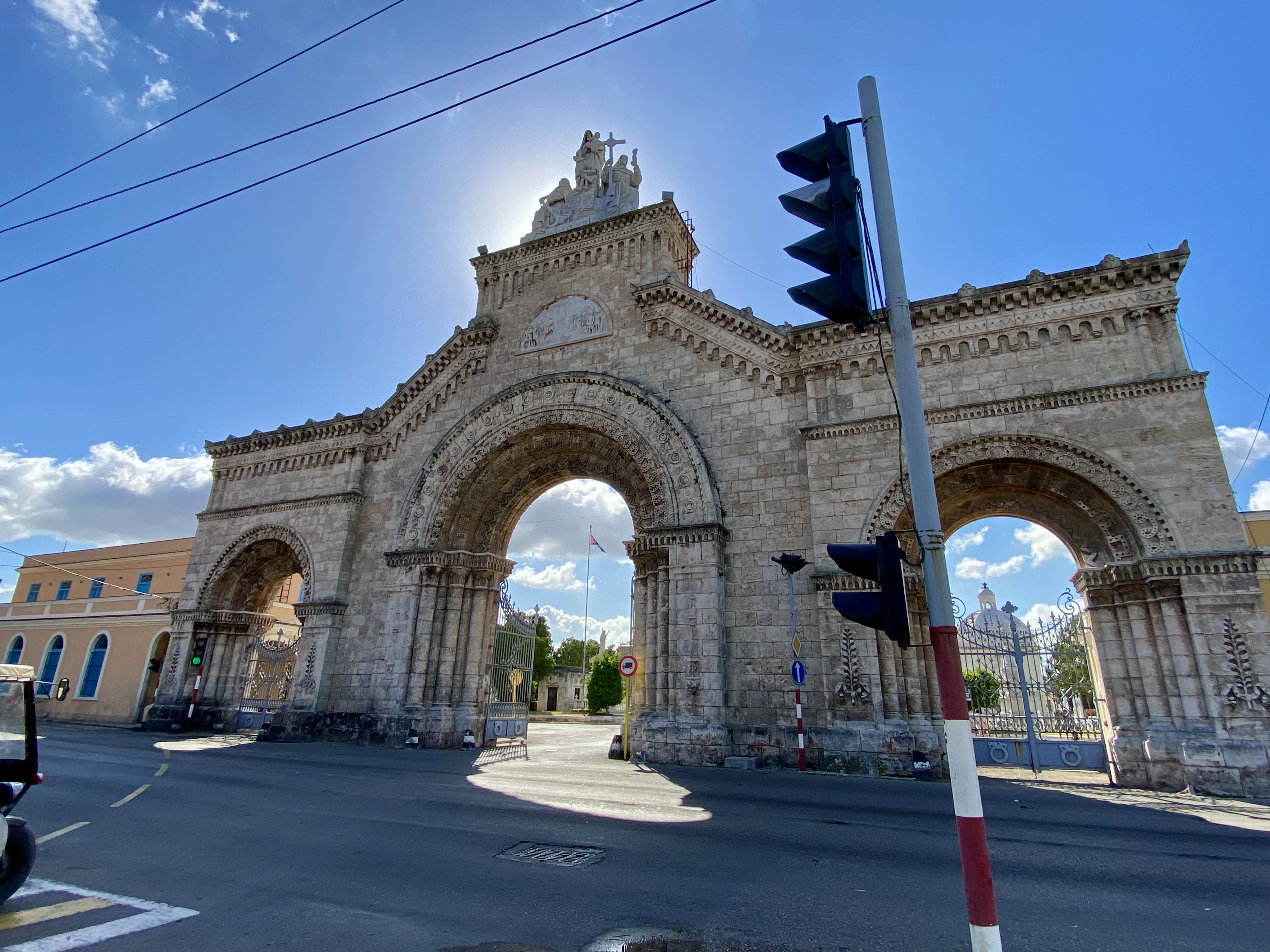
Monday Dec 9: At the Cine Yara we watched the feature, 1 hr. documentary La línea del ombligo, directed by Carla Valdés León, a film about how to preserve family memories, which gave us much food for thought. The film was part of the Festival de Cine Latinoamericano.
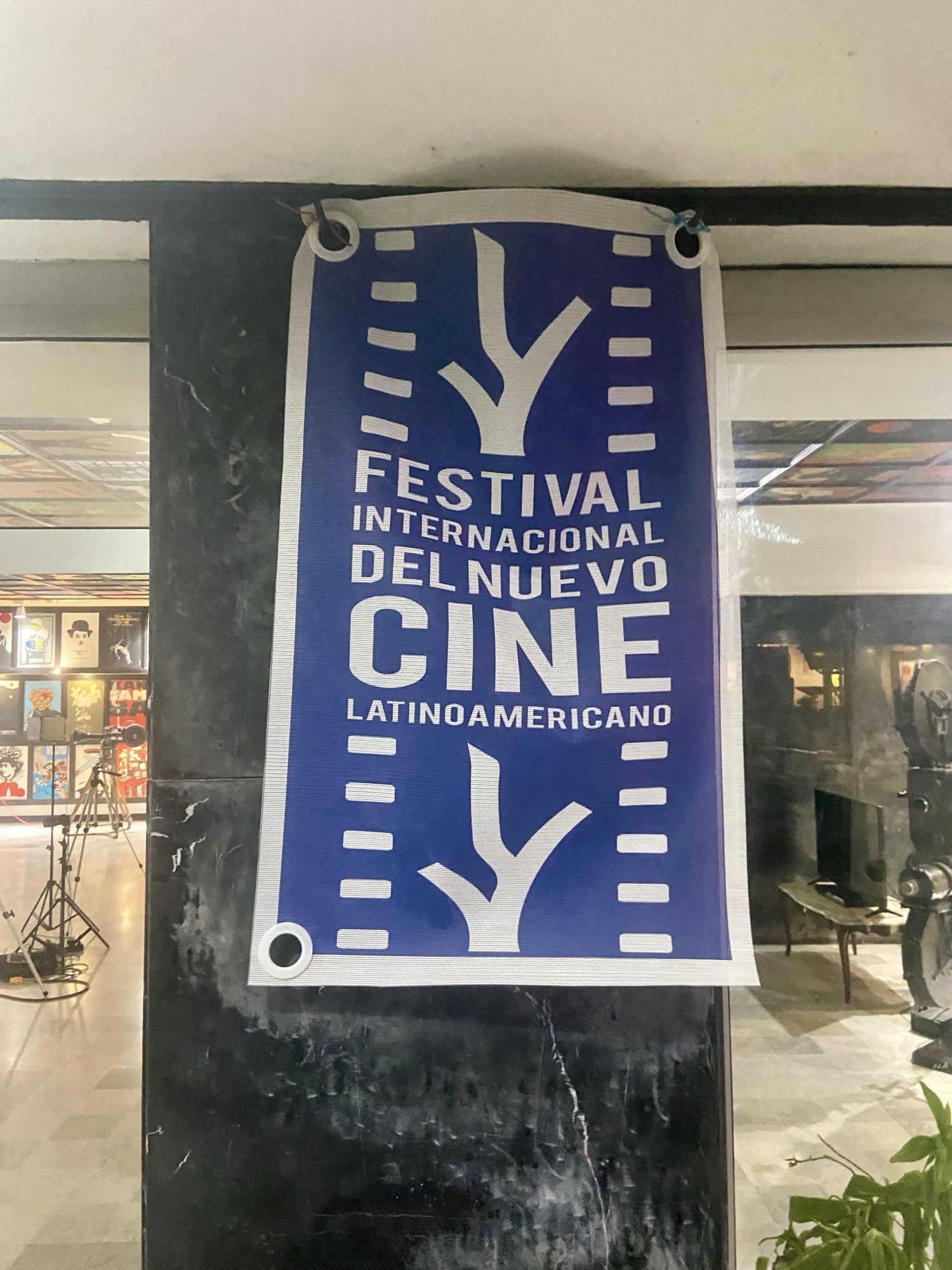
Tuesday Dec 10th: Marisa and I, accompanied by Elba Capote and Isabel James, visited the Instituto de Historia where we chatted with Belkis Quesada and Luis Montes de Oca. Later we stopped by the National Library where we were welcomed by Zohania Suárez and Juan Carlos Fernández. We delivered to them a 4TB large hard disk to support their digitization process. It was pleasant to see Juan Carlos again, eight years after he was part of the welcoming committee for the UC President’s Janet Napolitano’s semi-official visit.
Nota Bene: The BNJM has important collections, on Lezama Lima, Dulce María Loynaz del Castillo, Fernando Ortiz and others that doctoral students may want to excavate as part of their dissertation projects.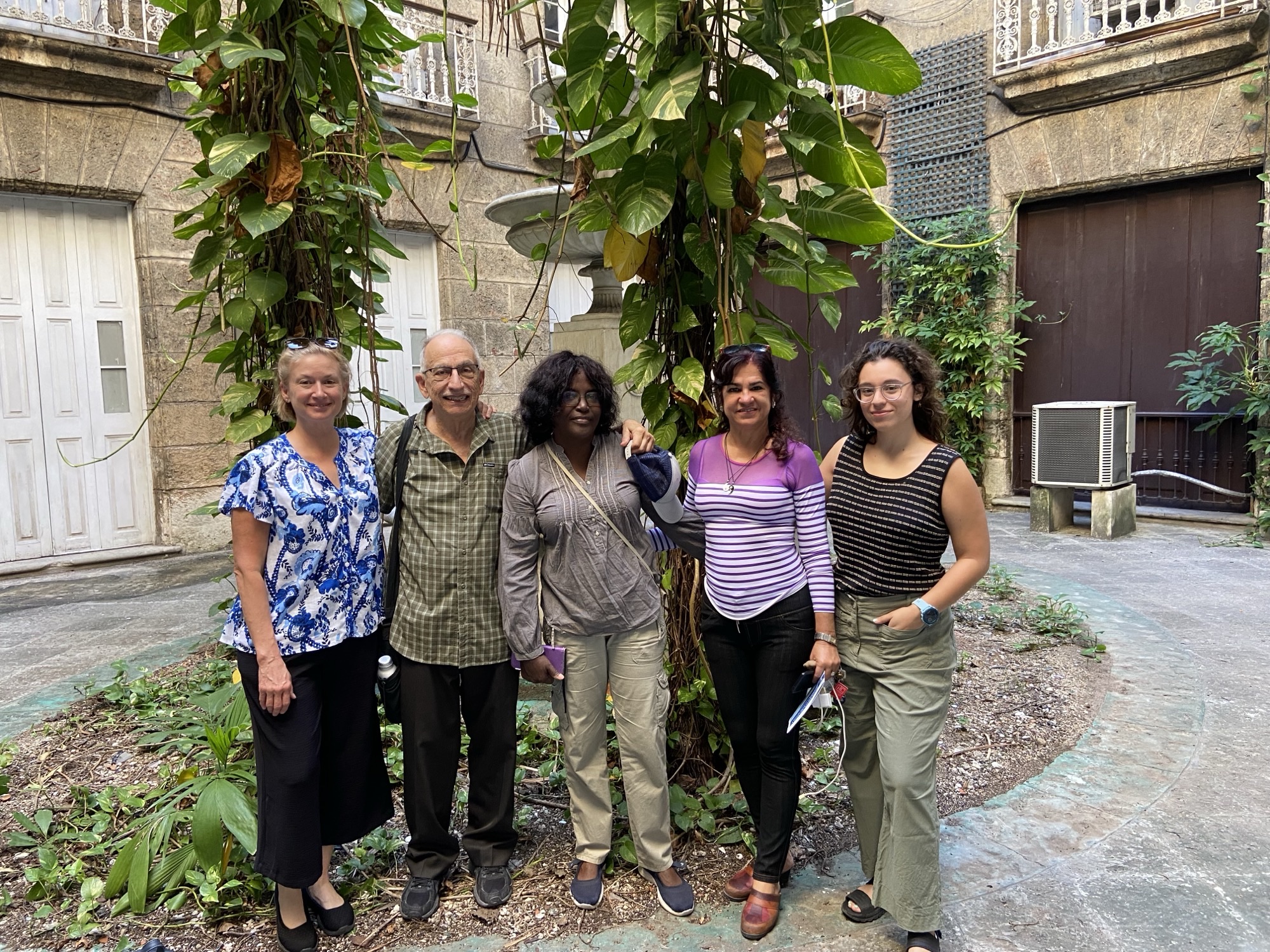
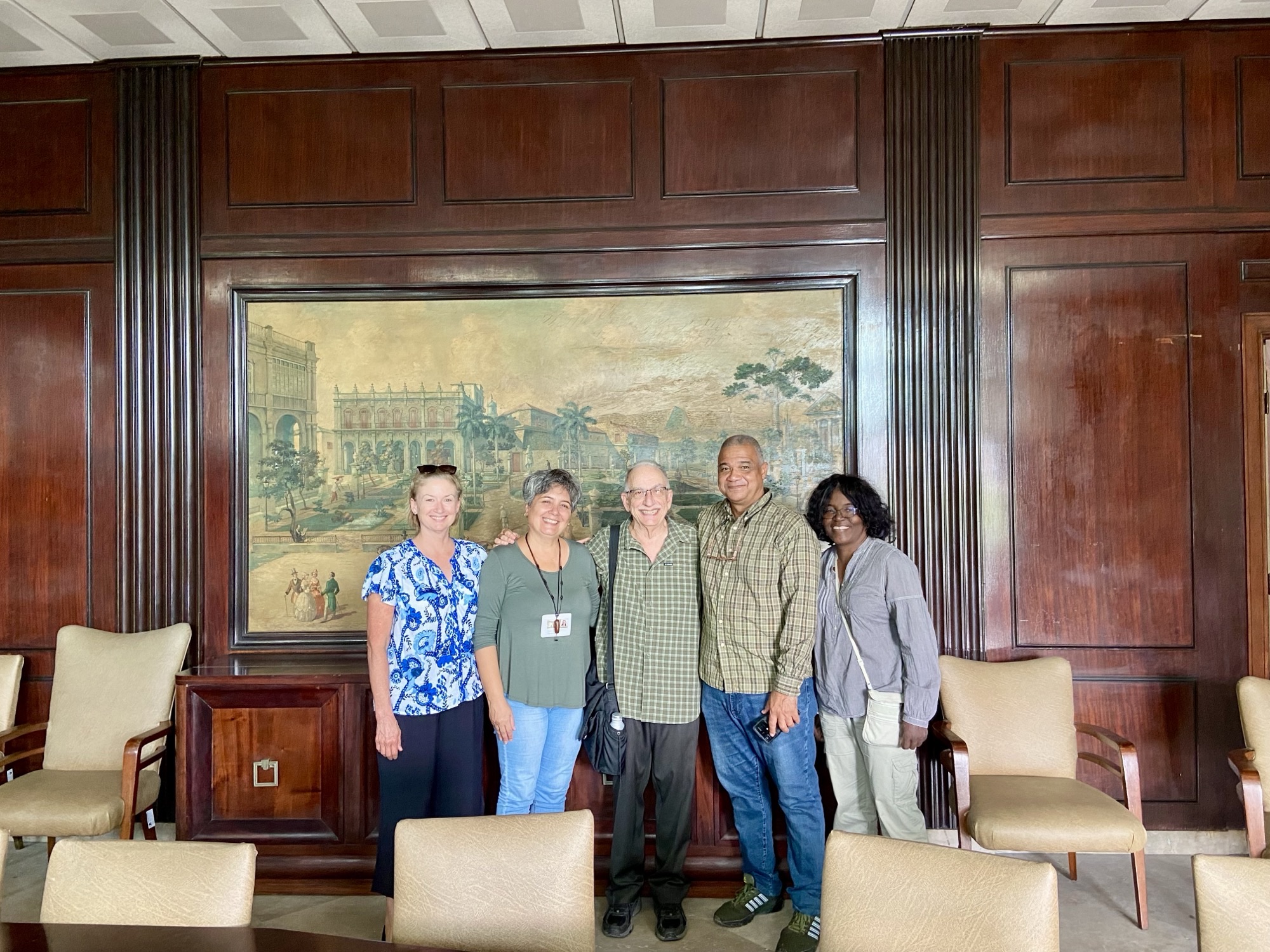
Wed Dec 11th: We visited the education center Casa-CUBA and conversed with its director, historian Rainer Schultz.
The highlight of the trip: In the afternoon we met and enjoyed a traditional dance performance by Barbara Morales and her dancing partner. We gave Barbara a copy of our colleague’s documentary El Sabroso and toys for her children.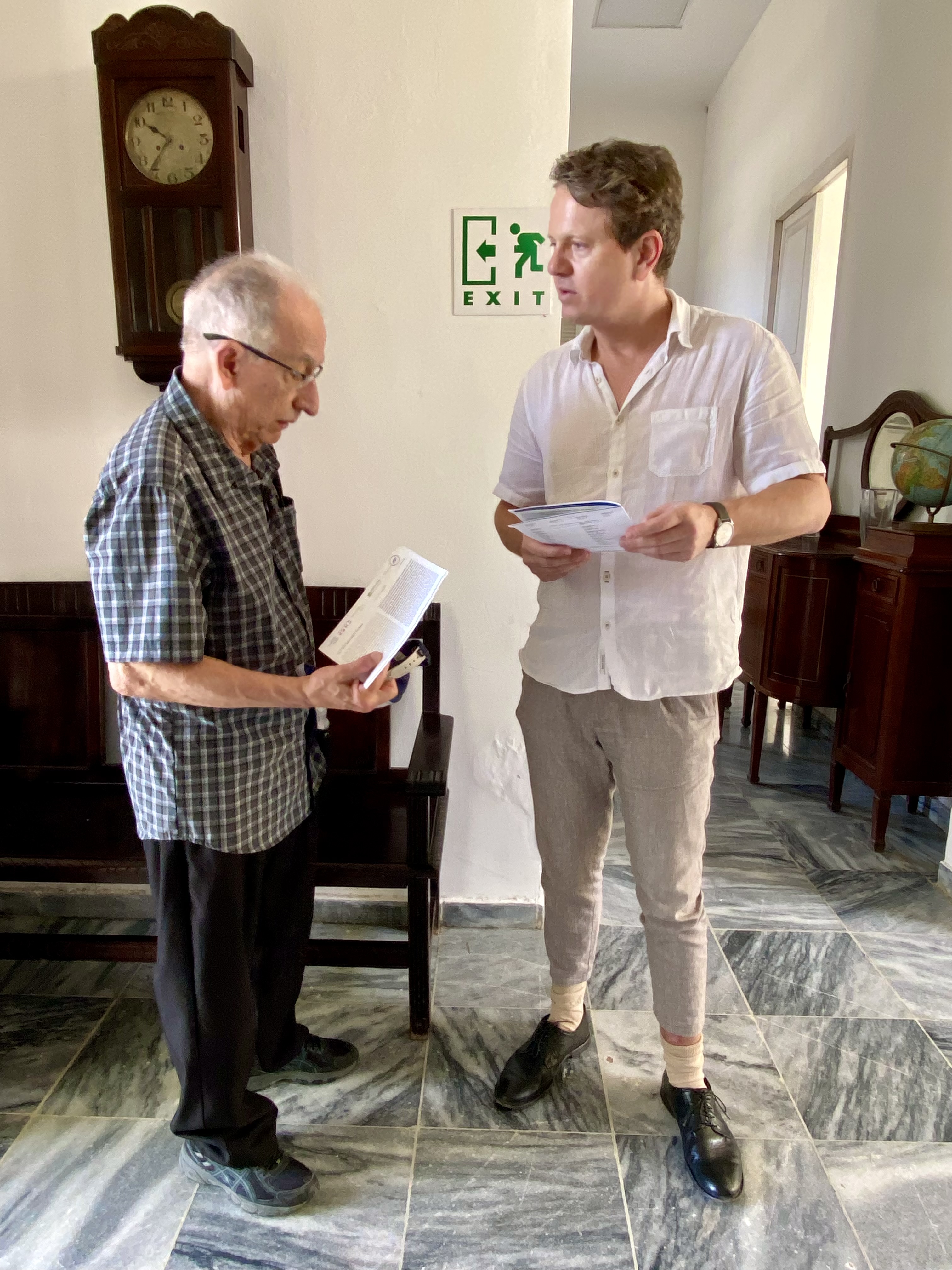

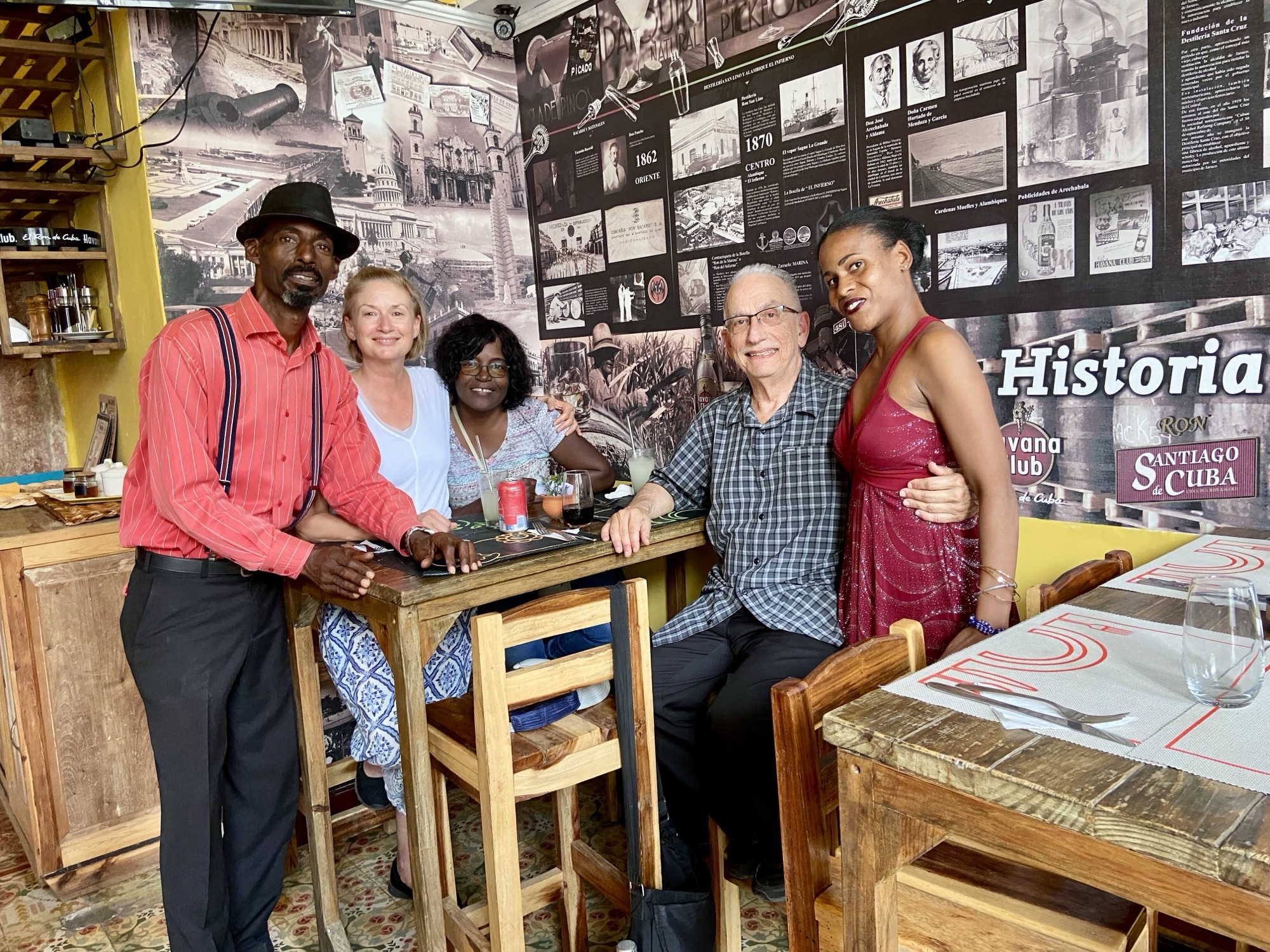
Thursday Dec 12th: In the morning, we paid a visit to our colleague Ana Niria Albo, delivered a letter from Anita Casavantes and discussed ways in which UC-CUBA students can access the vast library materials available at CASA. It was very windy and cold; we nearly froze for the picture taking.
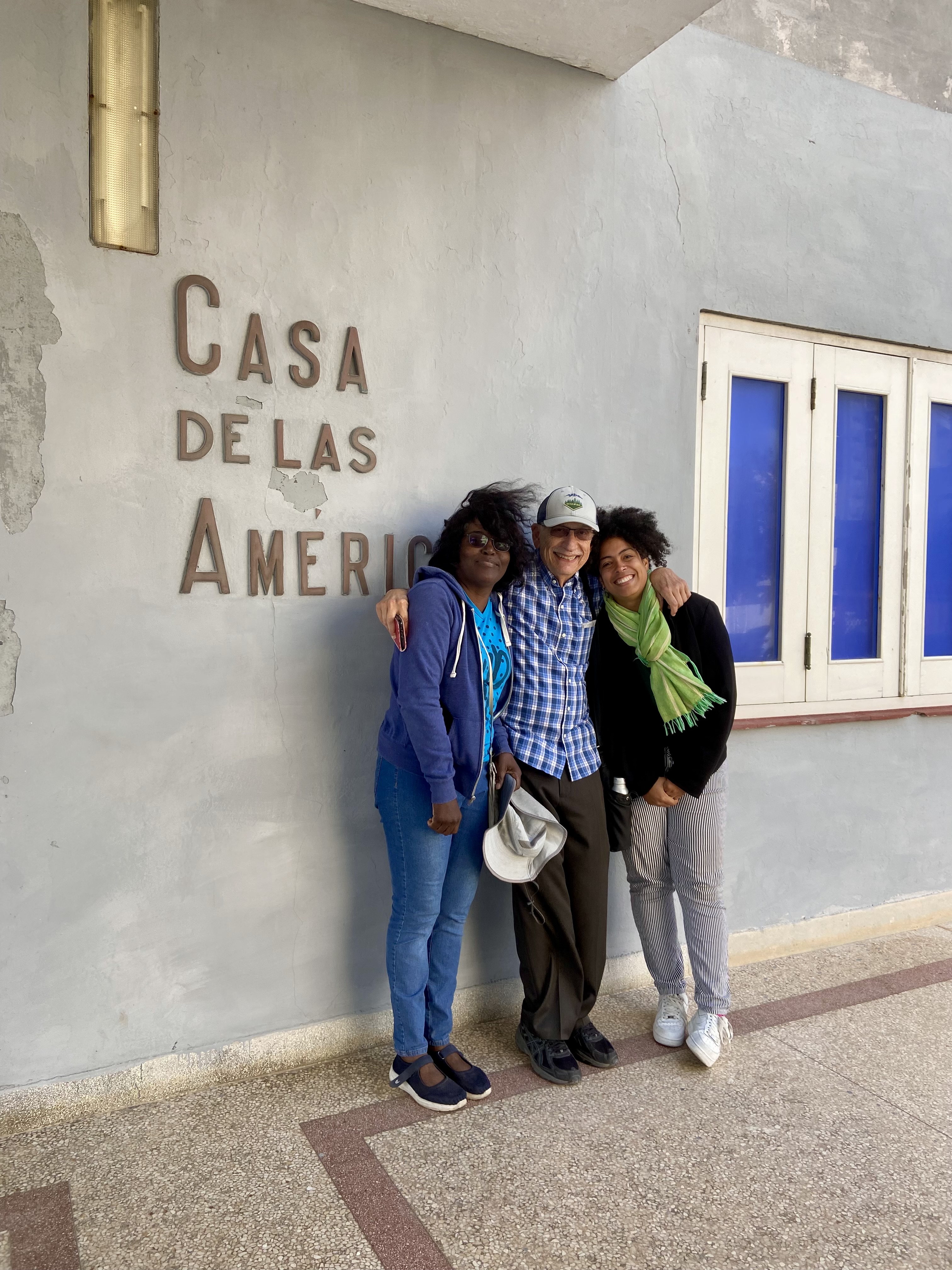
Nota Bene: The CASA Library has vast collections of Cuban and Caribbean Literature, Women’s Literature and Latin American Studies in general. It may be the best collection of Latin American Studies, surpassed only by the University of Texas’ holdings at the Austin campus.
Later we visited the home of Margarita González, the widow of late, great musicologist and writer Leonardo Acosta, and viewed numerous paintings by her father, the distinguished painter Ernesto González Puig (1913-1988).
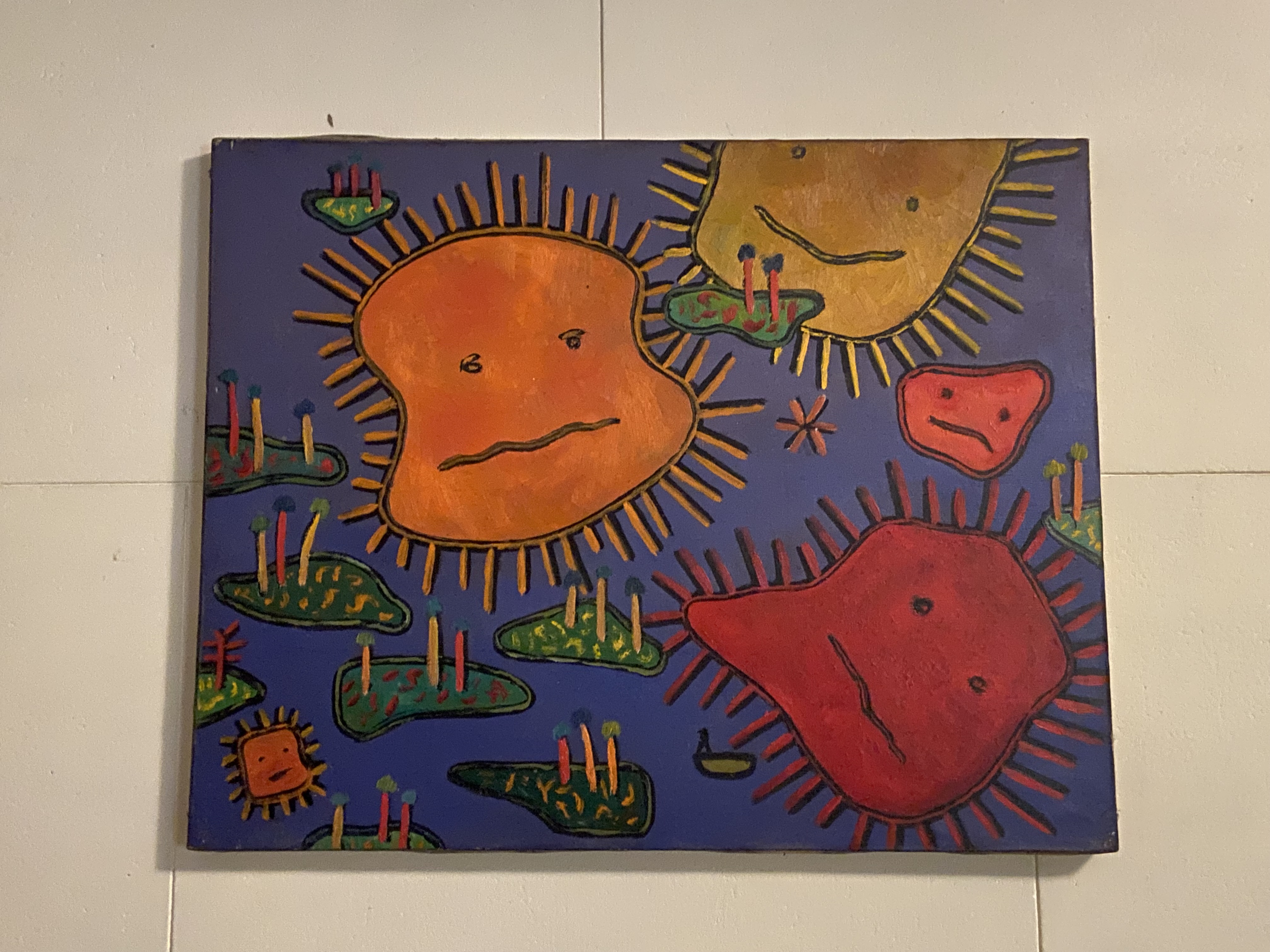
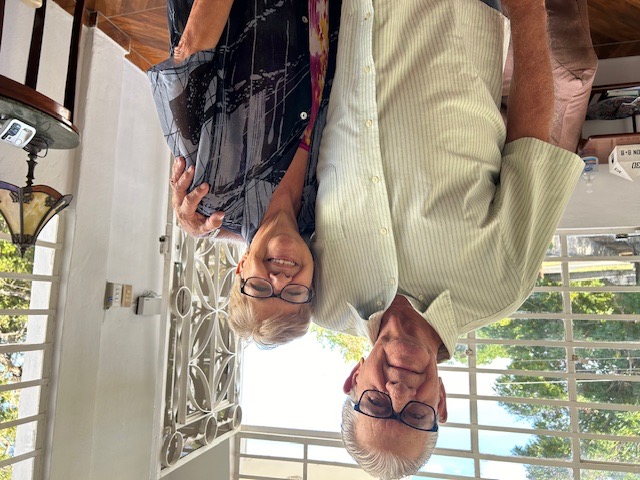
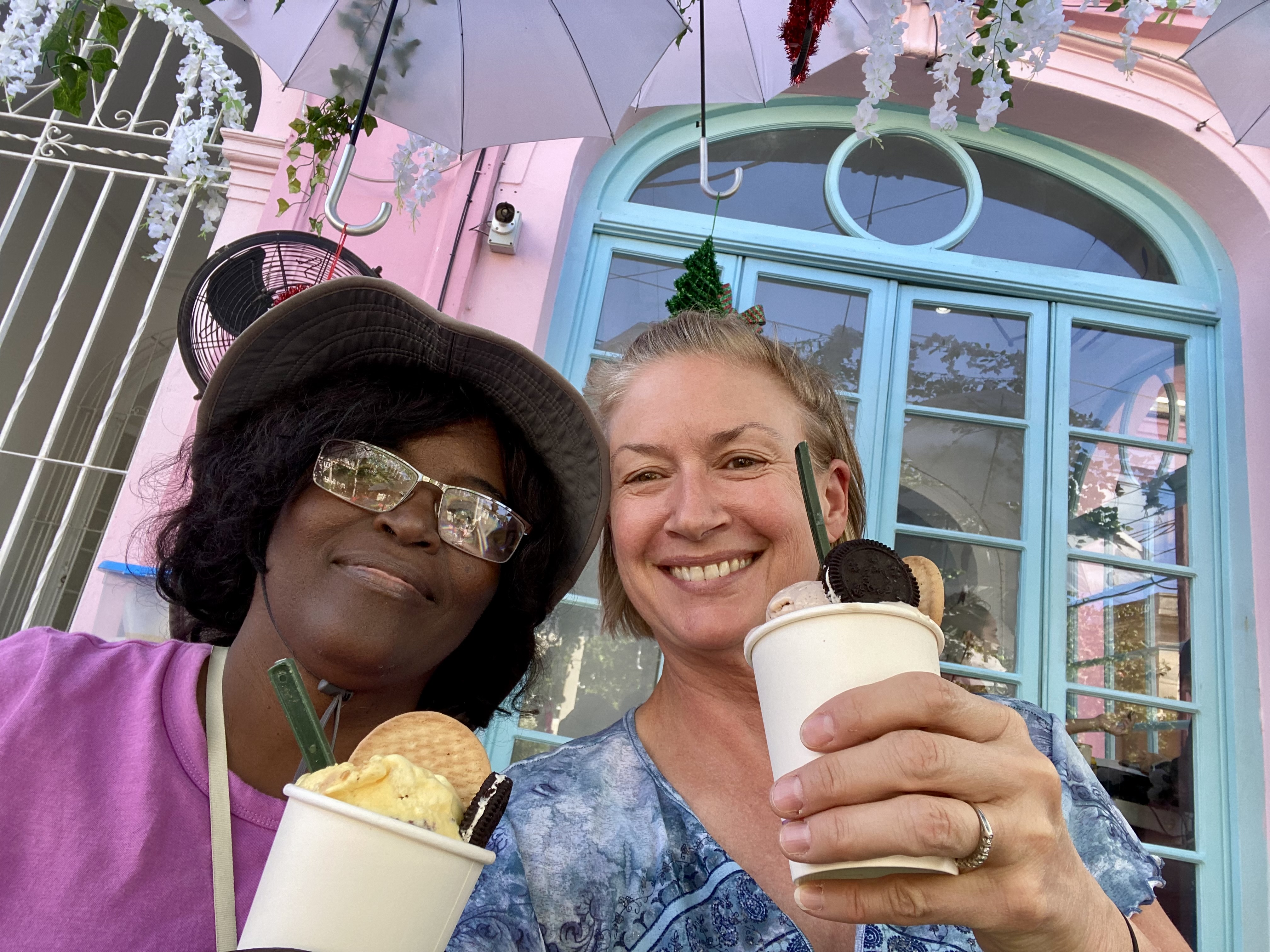
-
14th UC-CUBA Graduate Student Conference - Sights, Sounds, and Silences: Navegando la Cuba Actual e Histórica November 8, 2024
-
Cuba’s Medical Missions in Latin America
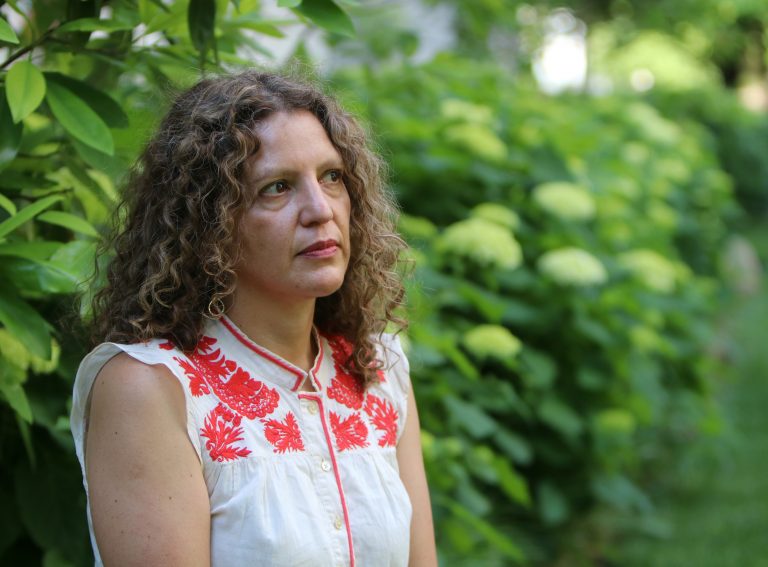
The distinguished Professor of History Tanalís Padilla (MIT) is working on a book about Cuba’s medical missions in Latin America. Professor Padilla is the author of several books on social movements in México. On September 20 she made a presentation, “The imaginario de la Revolución Cubana en la lucha de los normalistas rurales en México,” at the Primer Simposio Internacional de Investigación Cultural, sponsored by the Centro Juan Marinello in Havana. Professor Padilla’s presentation was based on her most recent book, Unintended Lessons of Revolution: Student Teachers and Political Radicalism in Twentieth Century Mexico.
-
EVENT ON U.S. Latinos at CASA DE LAS AMÉRICAS
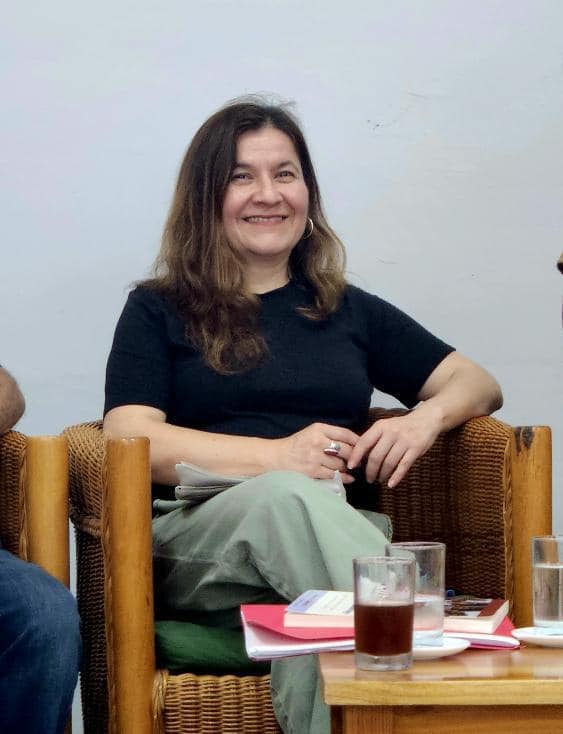
Profesor Alicia Estrada 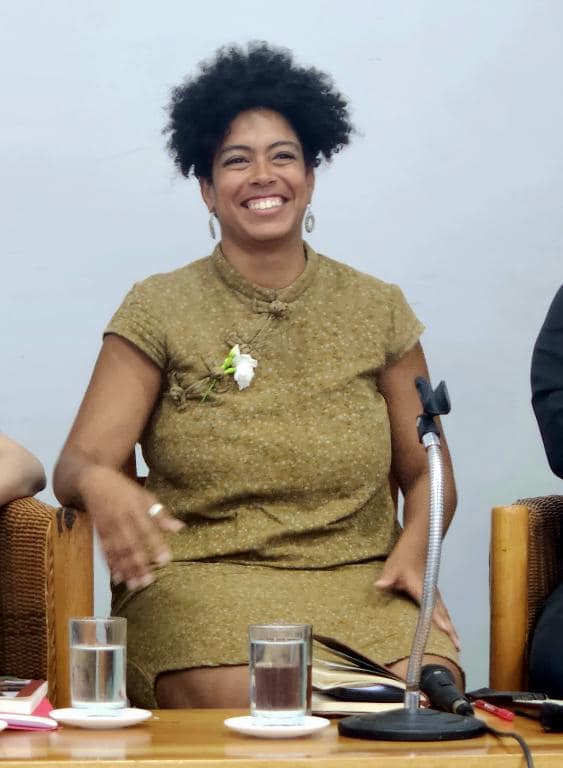
Subdirectora Ana Niria Organized by UC-CUBA’s longtime friend and collaborator Ana Niria Albo, Assistant Director of the Program on U.S. Latinos, CASA DE LAS AMÉRICAS featured in mid-April an event dedicated to the publication by CASA of the anthology (De)construyendo latinidades y movidas de descolonización, edited by Professors Martha Escobar and Alicia Estrada, of the Department of Chicana and Chicano Studies at CSUN.
Professor Escobar (Ph.D. UCSD) is the author of Captivity Beyond Prisons: Criminalization Experiences of Latina (Im)migrants, which considers the relationship of the U.S. prison system and (im)migration enforcement and the impact on Latina (im)migrants. Professor Estrada (Ph.D. UCSC) is co-editor with Karina O. Alvarado and Ester E. Hernández of the critical anthology U.S. Central Americans: Reconstructing Memories, Struggles and Communities of Resistance. Her current book project is on the Maya diaspora in Los Angeles.
In addition to interventions by Professor Estrada and Escobar other presenters included Ana Niria Albo, Professor Saul Maldonado from SDSU, and Dr. Patrick Velasquez, Co-Chair of the San Diego Chicano/Latino Concilio on Higher Education and Emeritus Professor and Student Affairs Administrator at UC San Diego.
-
Padura and Los rostros de la salsa
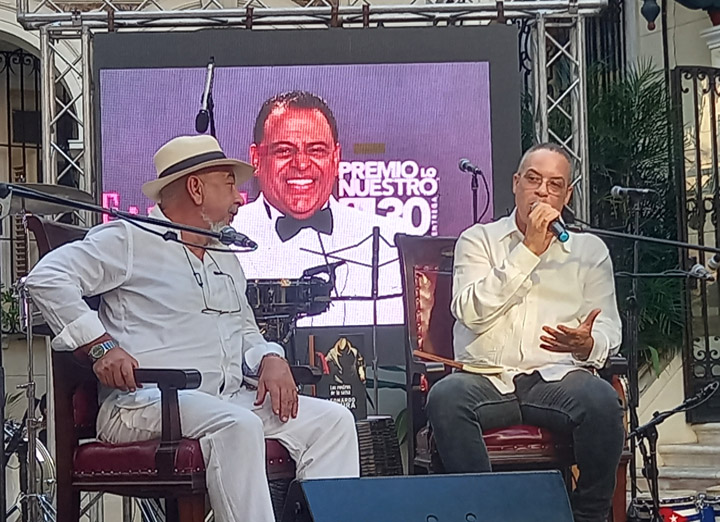
Padura e Isaac Delgado presentan Rostros de la salsa. | Image source: https://www.ipscuba.net/espacios/padura-lo-visto-y-no-visto/ Padura and Los rostros de la salsa.
Leonardo Padura’s book Los rostros de la salsa was presented on February 16, at the headquarters of the UNESCO Regional Office in Havana, with the presence of its author Leonardo Padura and the renowned Cuban musician Isaac Delgado, who closed the night in spectacular fashion with a performance in the company of his group and other prominent performers such as Roberto Fonseca. Republished by Aurelia Ediciones under the auspices of the UNESCO Transcultura Program whose motto is “Integrating Cuba, the Caribbean and the European Union through Culture and Creativity”, the book was also presented last year in the Dominican Republic.
Los rostros de la salsa was published in Cuba by Ediciones Unión in 1997 and by Planeta México in 1999. Aurelia's printing reproduces the one made by Tusquets Editores in 2020, which in addition to a prologue by UC-CUBA Secretary Raúl Fernández, includes the new interview conducted by Padura with Rubén Blades, one of the most representative musicians of that movement.
The book includes interviews conducted by Padura with other important figures such as Mario Bauzá, Tito Puente and Willie Colón, who marked an entire era of music in a geographical area that spans from New York to the Caribbean. Isaac Delgado, baptized at the time as “El Chévere de la Salsa” referred to his relationship with that rich and varied musical movement and the characteristics that had its impact on the island and in his own work, because although the origins of salsa owe a lot to Cuban music, there is no doubt that the salsa phenomenon meant a renewal of that valuable heritage.
-
Corporeal Readings of Cuban Literature and Art
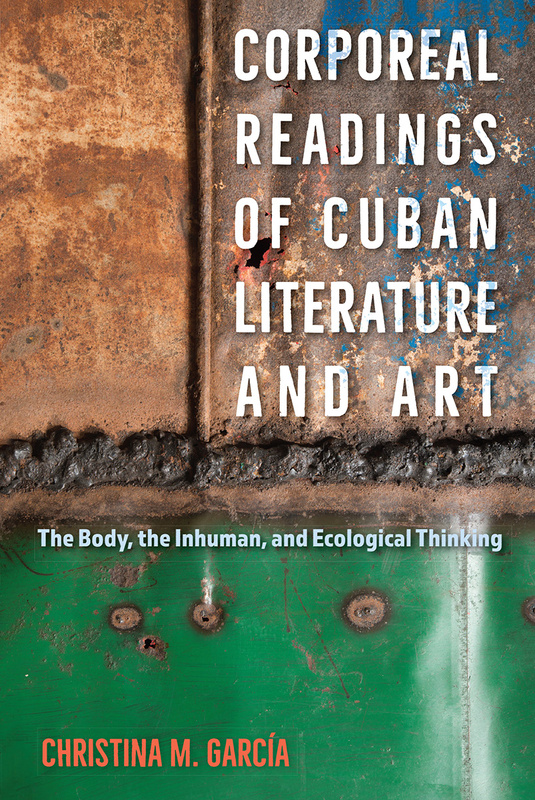
Corporeal Readings of Cuban Literature and Art
The Body, the Inhuman, and Ecological Thinking
by Christina M. García
Tracing corporeality and materiality across Cuban texts and images of the twentieth century
This volume looks at Cuban literature and art that challenges traditional assumptions about the body. Examining how writers and artists have depicted racial, gender, and species differences throughout the past century, Christina García identifies historical continuities in the way they have emphasized the shared materiality of bodies. García shows how these works interact with ecologies of the human and nonhuman across diverse media, time periods, and ideologies. -
REPORT ON CUBA TRIP 2023
Professor Burke, Marisa Santangelo and myself traveled to Cuba Dec. 1-10. Below a ‘preliminary’ report on our activities as related to UC-CUBA. We met several times with our support on-the-ground Marina Rodríguez, Tony Pérez, and Elba Capote. As some of you know a few of us in UC-CUBA collected some money to help Elba purchase an electric bike which is quite an impressive machine. Some of you were lucky to use it as a personal “taxi” during your recent visit!!
Visited Belkis Quesada and Luis Montes de Oca at the Instituto de Historia. We gave them copies of the program flier for our recent UCLA workshop, and Belkis was delighted to see so many names she recognized: Isabel James, Sara Kozameh, Tom McEnaney and so on… The three of us stopped by CASA de las Américas and had a long conversation with Ana Albo, the Associate Director of CASA’s Latinos in the U.S. Program. We also visited Yolanda Núñez and Zohaina Suárez at the Biblioteca Nacional José Martí. Yolanda is now the Subdirectora of the BNJM and Zohaina oversees the digitization program. Zohaina emphasized their continued interest in the digitization projects, and that their needs had shifted from preservation via digitization to digital preservation. This means that they need storage and noted that even small terabyte hard drives that UC-Cuba graduate students using the library could bring would be immensely helpful.
Raúl and Marisa met with the Director of the Museo Nacional de la Música, the distinguished musicologist Sonia Pérez. (Her husband is the renowned musician Barbarito Torres.) We informed Sonia about upcoming lectures by Professor Pierpaolo Polzonetti, from UC Davis, sponsored by another great musicologist Miriam Escudero, expert on 19th century contradanza.
We also briefly attended an event at CASA de las Américas where Professor Susan Eckstein presented her book Cuban Privilege, which details the various ways U.S. immigration policies have continually privileged Cuban migration to the United States after 1959. Ana Albo moderated the lecture, which was presented in English and interpreted into Spanish. The book and Professor Eckstein have been the unfortunate target of invectives by some members of the Cuban community in Florida.
In addition, Dr. Félix Valdés, from Instituto de Filosofía, paid us a visit at the ‘casa’ particular where we stayed; conversed briefly over the phone with the prominent writer Roberto Zurbano; stopped for refreshments at Cuba Libro, tried to check out the Fábrica de Arte (alas only open after our bedtime!), snapped souvenir pics in front of the Centro Fidel Castro, and took in a movie at the Festival de Cine Latinoamericano, the Argentine ‘clavo’ Náufrago.
At the end of our stay our entire support team of Marina, Tony, and Elba as well as the three of us provided logistical support and geographical and historical advice to USC Prize-winning writer and professor Andrew (Sandy) Tolan, author of several works of narrative non-fiction including The Lemon Tree about Palestinian-Israeli relations. Professor Tolan is working on his fourth book, an account of the 19th and 20th century sugar empire of several well-to-do Cuban families, their business successes as well as the conditions in which, first slaves, and later “freer” manual workers, labored in the sugar fields and mills of Matanzas and Santa Clara provinces. The book extends his reporting, mainly in Mother Jones, on exploitative and dangerous sugar work camps in the Dominican Republic owned by the same families.
-
La Ópera Italiana en Tiempos de Revolución
La Ópera Italiana en Tiempos de Revolución
Curso de Posgrado
Profesor: Dr. Perpaolo Polzonetti
Universidad de California, Davis -
13th UC-Cuba Graduate Student Conference in UCLA
-
The corneta china in Santiago carnival
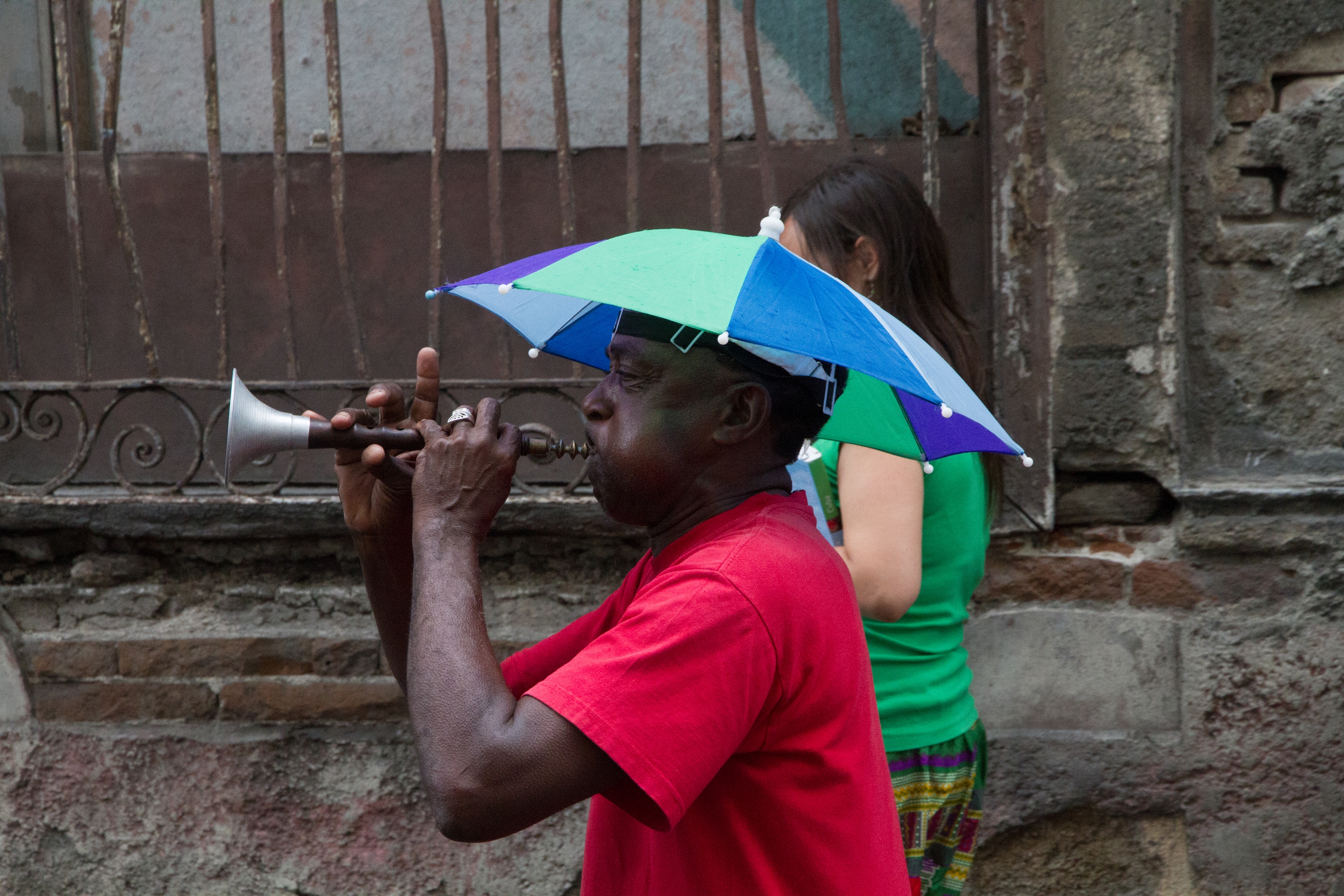
Frontman with trompeta china of the Conga de Tivoli in Santiago de Cuba, Photo by Christian Pirkl The corneta china is an instrument emblematic of the Santiago de Cuba carnival. It is the Chinese suona introduced to the island by Chinese immigrants in the late 19th and early 20th century. As Professor Bettina Ngweno (UC Davis) has indicated the same instrument is called in Kenya the Nzumari as well as a Persian cornet and it is played across the Indian Ocean by people of African descent. Dr. Alan Chan has used the corneta china in his jazz and classical compositions. Canadian saxophonist Jane Bunnet uses it in her Afro-Cuban jazz band.
-
12th UC-Cuba Graduate Student Conference at UC Irvine
-
Professors Burke and Fernandez visit to Cuba
Professors Burke and Fernandez visit to Cuba
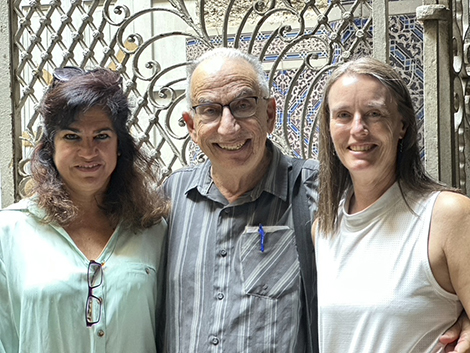
(from left to right) Belkis Quesada, Raul Fernandez and Nancy Burke Professor Nancy Burke and Raul Fernandez visited Havana (Dec12-18) to further UC-CUBA activities, develop potential new collaborations with local cultural institutions, and pursue their own research. Belos some highlights of the trip.
-We visited the Instituto de Historia de Cuba, the site of much archival research conducted by UC-CUBA doctoral students and discussed new ways of cementing our relationship with the Institute with its Director, historian Yoel Cordoví. Director Cordoví is also in the Editorial Board of the prestigious Cuban Studies journal published by the Center for Latin American Studies at the University of Pittsburgh. We were accompanied by one of our on-the-ground coordinators, Elba Capote.
-Professor Burke and Fernandez and Elba Capote visited the newly inaugurated Fidel Castro Center, a multipurpose institution similar in some ways to U.S. Presidential Libraries. We met with Director René González Barrios and were given a tour of the facilities. The research library, which contains a wealth of Castro’s documents, interviews, speech transcripts, etc., represents a significant resource for historical and political research.
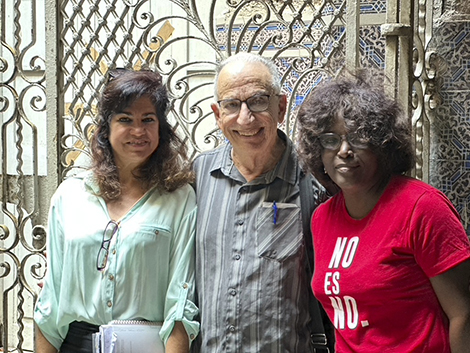
(from left to right) Belkis Quesada, Raul Fernandez and Elba Capote - Professor Burke and I met with Isabel James (Geography, UCLA) one of the students organizing the next UC-CUBA graduate workshop to discuss details of the upcoming event (February 3, 2023) at UC Irvine. We held the meeting at the CUBA LIBRO Space, a circulating library of English-language books run by long-time American expatriate Conner Gorry. CUBA LIBRO houses several books from UC-CUBA faculty and alumni.
-We held discussions about future activities with our other on-the-ground supporters on the ground, Antonio Pérez and Marina Rodríguez.
-Professor Fernandez obtained several copies of his book Ontología del son, recently published in Cuba by Editorial Letras Cubana. This book contains 20 published and unpublished articles in Spanish, that he authored on Cuban music and musicians between 2005-2021 some of which appeared in earlier versions in academic and non-academic journals in Cuba, Puerto Rico, Colombia, as well as online. All articles were edited and revised for the published collection.
-
Radamés Giro - A great friend in the Cuban music family
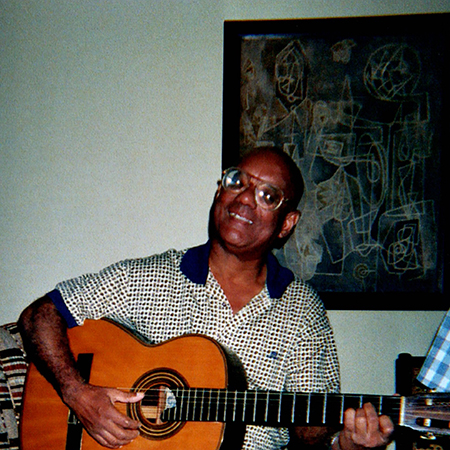
Radamés Giro, musician, author, editor, and self-taught researcher and musicologist was a central figure of Cuban music over the last 50 years.
Perhaps his most striking work was the publication in 2007 of the monumental Diccionario enciclopédico de la música en Cuba (DEMC), four volumes in the original edition, which covers 1169 pages, more than 2,000 entries and 600 photos and scores. The fruit of 40 years of study and compilation, the "Diccionario de Radamés", as it came to be called, is of enormous use for writers, music and literature critics, researchers, journalists, record companies, disc jockeys, and all those who, being specialists or not, need references, ideas, and solid data about music in Cuba.
Born in Santiago de Cuba, Radamés grew up in musical surroundings par excellence. His house provided rehearsal space for the Conjunto Hermanos Giro, in which his father played tres and his uncles Carmelo and Claro guitar and conga respectively. One of Radamés’ first mentors was his maternal grandfather, the legendary sonero and guitarist Ángel Almenares. The young Radamés then studied formal guitar with Professor Esteban Castillo. In the end, Radamés put aside his potential as a concert musician, and for several years served as guitarist in several local musical ensembles, such as the group Avances del 56, the trio Los Románticos, the combo of Conrado Wilson, and as an accompanist of popular singers like bolerista Orlando Contreras.
As a result of an unfortunate incident in his adolescence, Radamés completely lost vision in one eye and suffered from limited vision in the other for the rest of his life. And yet this was no obstacle to the work he later developed as a researcher, author, and editor. In addition to the Diccionario, Radamés wrote several major studies of capital importance for the study of Cuban and Latin American music. Worth mentioning are his monographs on the history of the guitar in Cuba, the bolerista César Portillo del Luz, the Brazilian composer Heitor Villalobos, and the renowned guitarist, composer and conductor Leo Brouwer. Another work of great relevance is Cincuenta canciones en años de revolución, a selection made in collaboration with his wife Isabel González Sauto, which contains biographical notes and the scores of fifty songs that can represent as the authors say, "a chronicle of those fifty years", from 1959. The biographical notes, succinct but dense, constitute a small dictionary of 27 composers. The songs chosen by Giro and González Sauto range from the tearful to the erotic without skipping the political.
Radamés authored more than thirty articles for journals specializing in musical topics. As editor, beginning in the 1970s, Radamés oversaw the editing and publication of more than 100 titles dedicated to and/or including reissues of authors and composers such as Ignacio Cervantes, Leonardo Acosta, Argeliers León, Alejandro García Caturla, and Fernando Ortiz. Of particular significance was Radamés’ work in the search, edition, compilation, and dissemination of the totality of the work that Alejo Carpentier dedicated to music before and after the publication of Carpentier’s La Música en Cuba in 1946. The Museo Nacional de la música published Radames’ comprehensive edition of Carpentier's musical studies and commentary on it by several musicologists in La música en Cuba/Temas de la lira y del bongó.
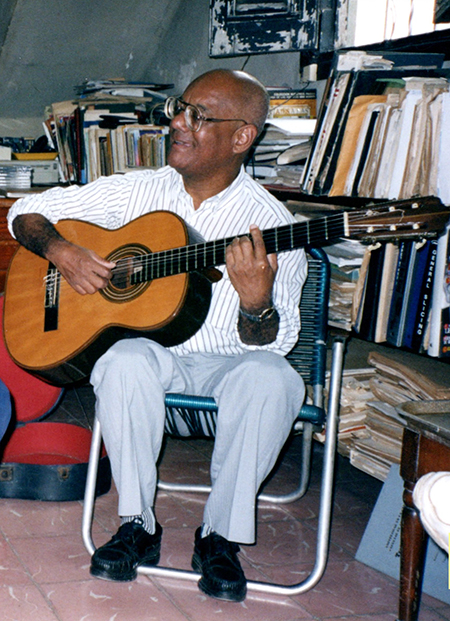
Of notable importance too was the edition of a series of volumes based on interviews with dozens of Cuban musicians that make up an expansive oral history of Cuban popular music in the voice of its composers and performers, material of extraordinary value for the student of popular music, for example La música en persona by Erena Hernández, Ellos hacen la música by Raúl Martínez Rodríguez, y Cubanos en la música by Mayra Martínez. Two collections deserve particular note, El mambo, in which Giro makes a careful selection of texts aimed at differentiating between the various meanings of the word, and to find out who was its 'inventor' attributed, depending on the time and place, to Arsenio Rodríguez, Pérez Prado, Arcaño, and Cachao Lpez, among others; and the edited volume Panorama de la música popular cubana, with chapters dedicated to the history and character of every major genre of Cuban popular music. Finally, Giro supervised the translation and publication in 1973 of the Oxford Dictionary of Music, an essential reference for scholars of universal music. For his labors Radamés received the Distinción por la Cultura Nacional, the Raúl Gómez García and the Adolfo Guzmán Medals, and the Premio Nacional de Edición in 1999.
Of special interest is an interview conducted with him by writer Leonardo Padura which appears as a chapter in Padura’s Los rostros de la salsa. In his interventions Radamés establishes with safe and astute criteria the historical and technical relationship between salsa, as it was developed mostly by Nuyorican musicians, and the son and other genres of Cuban music.
During his lifetime Radamés shared his expertise with great generously with scholars inside and outside the country. There are numerous researchers in Cuba who sought his good advice. It is rare for an international researcher not to have consulted Radamés on matters related to Cuban music. Several foreign experts subsequently published notable studies on the subject. Radamés was a consultant for the Smithsonian Institution Latin Music Oral History Program lending his support for interviews with Richard Egües, Frank Emilio Flynn, Luis Carbonell, Celina González, Félix Guerrero, Enrique Bonne, Rodulfo Vaillant, Tata Güines and other artists in Havana and Santiago de Cuba in 1998-2004.
Given the well-deserved fame of Radamés Giro as a 'detective' of music in Cuba, we should not be surprised that the writer of 'detective' novels Leonardo Padura, himself an enthusiast of popular music, brilliantly incorporated the musicologist in his work La neblina del ayer, in which the character "Rafael" Giro, a faithful portrait of the Radams Giro of real life, assists as a musical specialist to homicide detective Mario Conde.
With Radams Giro’s death, Cuban musicology loses one of its great figures, a talented, generous, and collegial person. A great friend in the Cuban music family of his friends.
Raúl Fernández
Professor Emeritus
Unveristy of California, Irvine
https://temas.cult.cu/articulos-academicos/radames-giro-y-la-investigacion-de-la-musica-en-cuba/ -
"Personas decentes," just released novel by Leonardo Padura.
Cuban novelist Leonardo Padura just released his latest novel "Personas decentes." It represents the "come back" of detective Mario Conde. This book constitutes a new chapter in the saga that covers more than thirty years of writing. The plot is set in the days prior to the arrival of President Barack Obama on the island in the spring of 2016.
-
Celia Cruz in Los Angeles 1959
Celia Cruz made appearances in Los Angeles in the late 1950s in shows organized at the Hollywood Palladium and other venues by Mexican-American trombonist, bandleader, music promoter and radio announcer Lionel “Chico” Sesma.
Through his “Latin Holidays” concerts at the Hollywood Palladium “Chico” Sesma introduced Los Angeles audiences to Cuban artists and ensembles like Benny Moré, Sonora Matancera, Orquesta Aragón, and the Queen of Salsa Celia Cruz.
In the photo Celia Cruz at the Hollywood Palladium accompanied by the Orquesta Nuevo Ritmo de Cuba featuring local musicians Rolando Lozano, Pupi Legarreta and “Cuco” Martínez.
-
The Sun of Jesús del Monte
The Sun of Jesús del Monte
El sol de Jesús del Monte, a Cuban anti-slavery novel written by Andrés Avelino de Orihuela in 1852, the same year as Harriet Beecher Stowe’s Uncle Tom’s Cabin (which Orihuela had translated into Spanish), was neglected for 150 years until its republication in Spanish in 2008.
Virginia University Press has just released our colleague David Luis-Brown's translation and critical English edition THE SUN OF JESÚS DEL MONTE 2022.
The SUN OF JESÚS DEL MONTE is the only Cuban novel of its time to focus on La Escalera, the major anticolonial and slave insurrection o 1843–44. It offers readers the most detailed portrait of the everyday lives and plight of free people of color in Cuba in any novel up to the 1850s.
-
11th UC-Cuba Graduate Student Conference at UC Merced
-
Danzones lost for a century: Joyas Inéditas
For several decades the danzón was regarded as Cuba’s national dance. A novel mixture of the old Spanish contradanza and Afro-Cuban melodic and rhythmic elements, the first known danzón was premiered by Miguel Failde and his orchestra in Matanzas in 1879 and titled “Alturas de Simpson,” celebrating one of the city’s barrios.The danzón spread to the Dominican Republic, New Orleans, and Mexico, where even today it is cultivated with passion.
A handful of danzón scores from the late 19th century, lost in the archives of the city of Matanzas, lay forgotten for more than 100 years until they are now rescued. Joyas Inéditas of the Failde Orchestra contains four of the recovered danzones. The Failde Orchestra is currently conducted by Ethiel Failde, great-great-grand nephew of Miguel Failde, widely regarded as the creator of the danzón.
A team of musicologists scoured the archives of several Matanzas institutions such as the Provincial Library, the Concert Band archive and the local museum to find them, after detecting that despite the fact that the danzón was born in 1879 in this city, there were not many written signs of it until the first decade of the 20th century.
Among the 16 pieces that slept for more than a century, four are part of the album Joyas Inéditas, produced by the Egrem label with arrangements and interpretation by the Failde Orchestra, led by flautista Ethiel Failde. Recorded in February 2021, it contains the lost danzones “El naranjero,” “Cuba Libre,” “A La Habana me voy” and “Nievecita,” all compositions of Miguel Failde.
-
New Books, New Voices: A Virtual Conversation with the Authors
Moderated by
Dr. Anita Casavantes Bradford, UC Irvine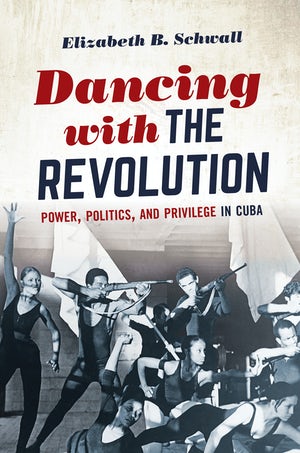
Elizabeth B. Schwall,
Assistant Professor of History
Northern Arizona UniversityAs esteemed artists, Cuban dancers have often used their art to posit more radical notions of social justice than political leaders were able or willing to implement. After 1959, while generally promoting revolutionary projects like mass education and internationalist solidarity, they also took risks by challenging racial prejudice, gender norms, and censorship, all of which could affect dancers personally. This exciting new book sheds powerful new light on how dance, too often overlooked in histories of Latin America and the Caribbean, provides fresh perspectives on what it means for people, and nations, to move through the world.
Dr. Elizabeth Schwall has taught at Stanford University and the University of California, Berkeley; she also held a fellowship at New York University's Center for Ballet and the Arts, and was a postdoctoral fellow at Northwestern University. Her work has appeared in the Hispanic American Historical Review, Cuban Studies, Gender & History, and Dance Chronicle.
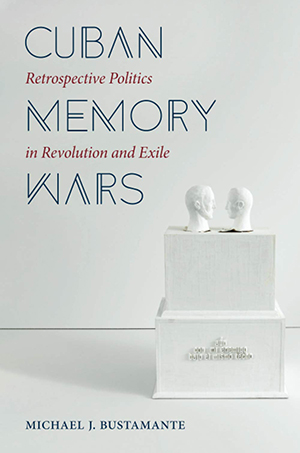
Michael J. Bustamante,
Associate Professor of History & Chair in Cuban-American Studies
University of MiamiFor many Cubans, Fidel Castro’s Revolution represented deliverance from a legacy of inequality and national disappointment. For others—especially those exiled in the United States—Cuba’s turn to socialism made the prerevolutionary period look like paradise lost. Unsettling this familiar schism, this powerful now book excavates Cubans’ contested memories of the Revolution’s roots and results over its first twenty years, revealing how these battles over the past not only defied simple political divisions— but also helped shape the course of modern Cuban history.
Dr. Michael J. Bustamante is co-editor of The Revolution from Within: Cuba, 1959-1980 (Duke, 2019). He has written for the Journal of American Ethnic History, Latino Studies, Cuban Studies, and Journal of Latin American Cultural Studies.
MODERATOR
Anita Casavantes Bradford,
Co-Director of UC Cuba & Associate Professor of Chicano/Latino Studies and History
University of California, IrvineOur Moderator, Dr. Anita Casavantes Bradford is the author of The Revolution is for the Children: The Politics of Childhood in Havana and Miami, 1959-1962 (University of North Carolina Press 2014) and of the forthcoming book, Suffer the Little Children: Child Migration and the Geopolitics of Compassion in the United States (University of North Carolina Press 2022). Her work has appeared in Cuban Studies, Latin American Research Review, Journal of American Ethnic History, Diplomatic History, and the Journal of the History of Childhood and Youth.
-
Ada Ferrer's CUBA: An American History
Ada Ferrer's CUBA: An American History
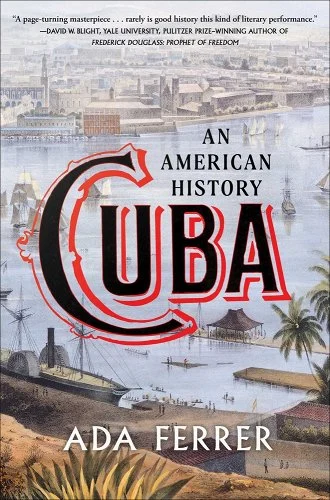
The just released CUBA: An American History, is medicine codified as history.
It is a prodigious distillation of the best available scholarship on Cuba's history and U.S.-Cuba historical relations. Reading it you won't have to read several dozens books and hundreds of articles and documents in English and Spanish.
CUBA: An American History is everything the book blurbs and early reviews say it is. A masterpiece, a literary performance, an epic, sweeping , riveting, nuanced, fluid, informative, remarkable work of history.
Ada Ferrer, a Professor of History at NYU, is a distinguished historian of Cuba who has previously written two prized-winning monographs: Insurgent Cuba: Race, Nation, and Revolution, 1868-98,University of North Carolina Press, 1999, and Freedom's Mirror: Cuba and Haiti in the Age of Revolution, Cambridge University Press, 2014.
Her most recent book is a necessary, obligatory reference for Cuba scholars.
-
Sixty Years After the Bay of "Pigs" - Playa Girón Invasion
Sixty Years After the Bay of "Pigs" - Playa Girón Invasion
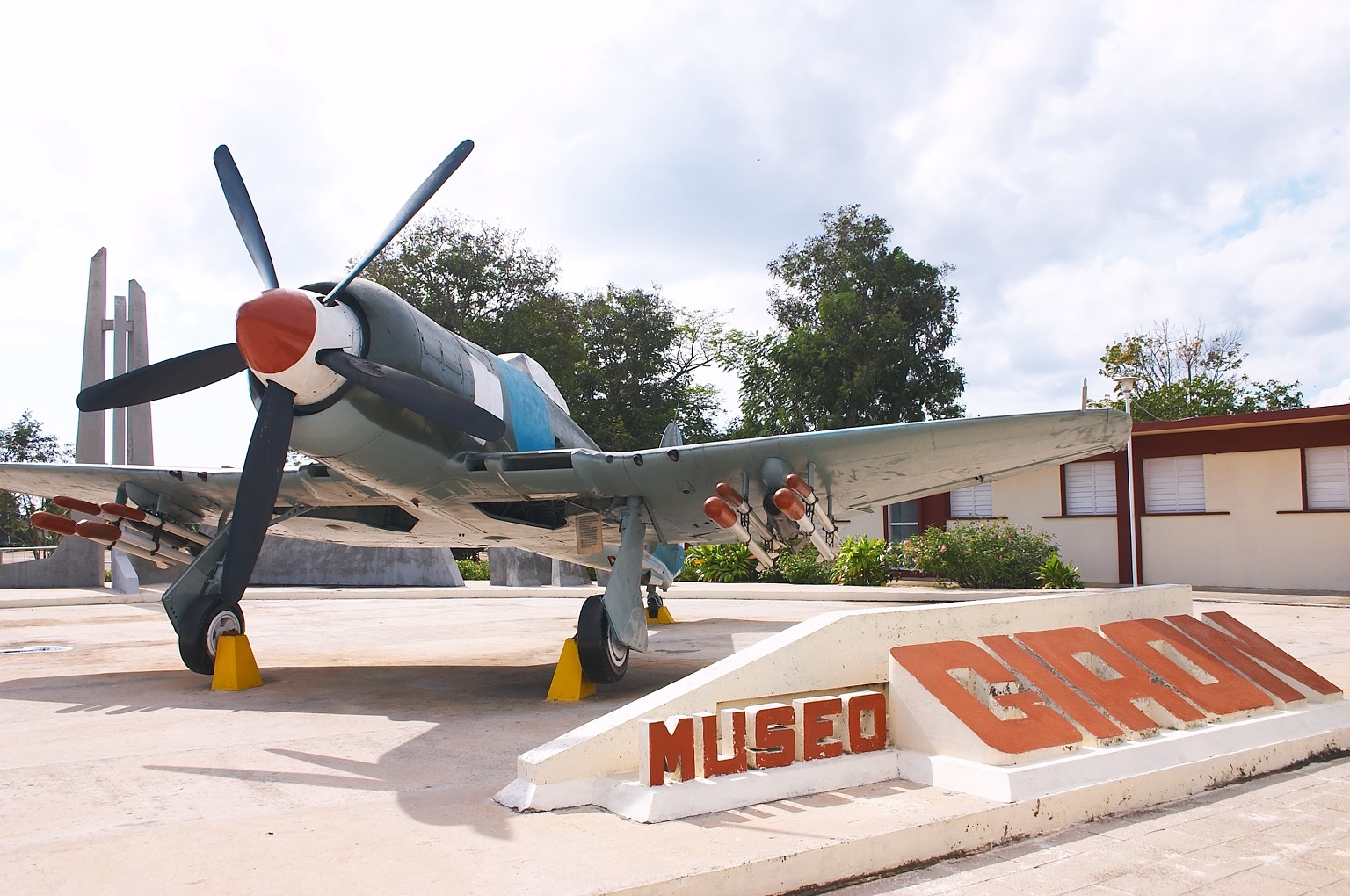
Entrance to Museo Playa Girón
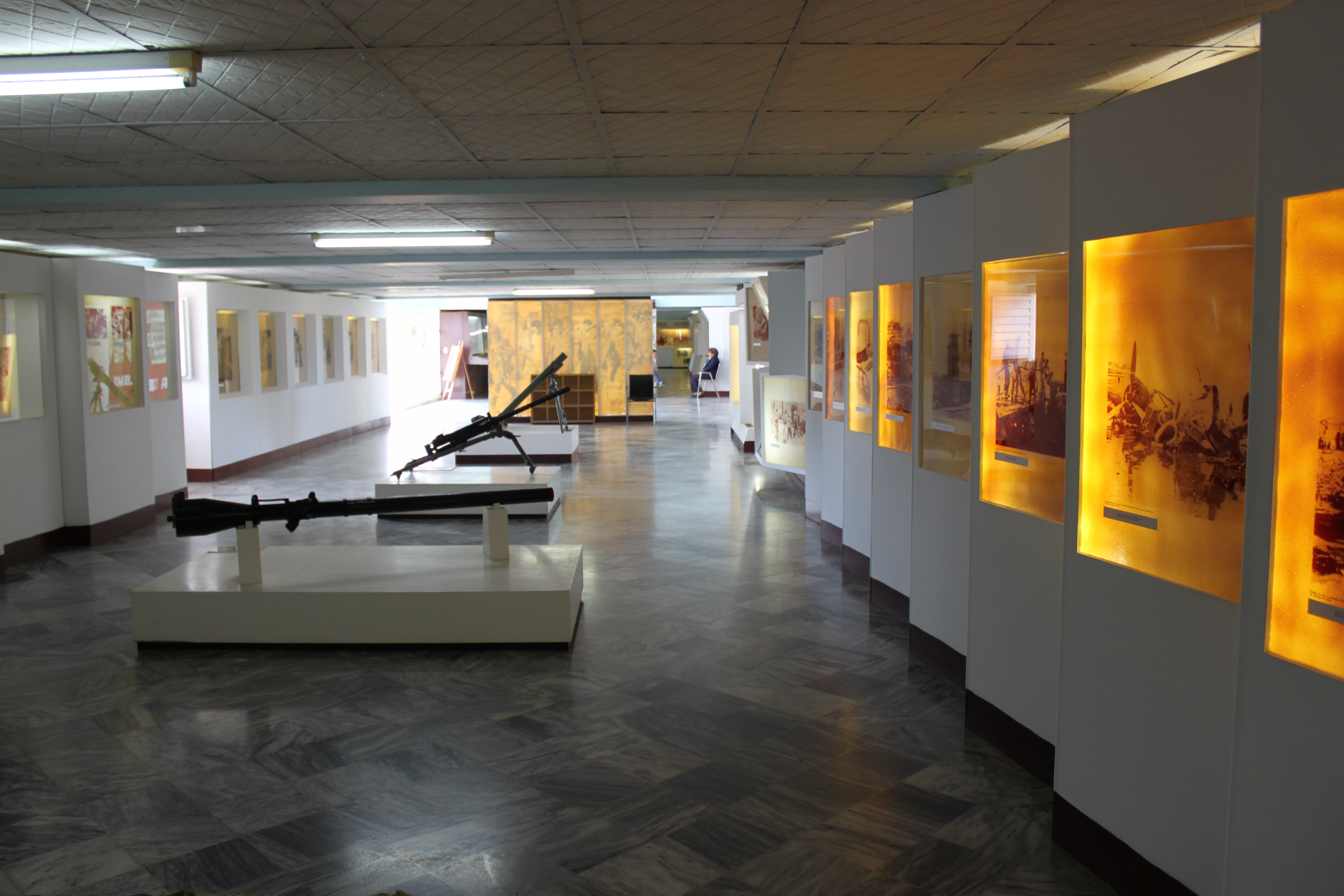
A view down the hall of the Museo of Playa Giróm
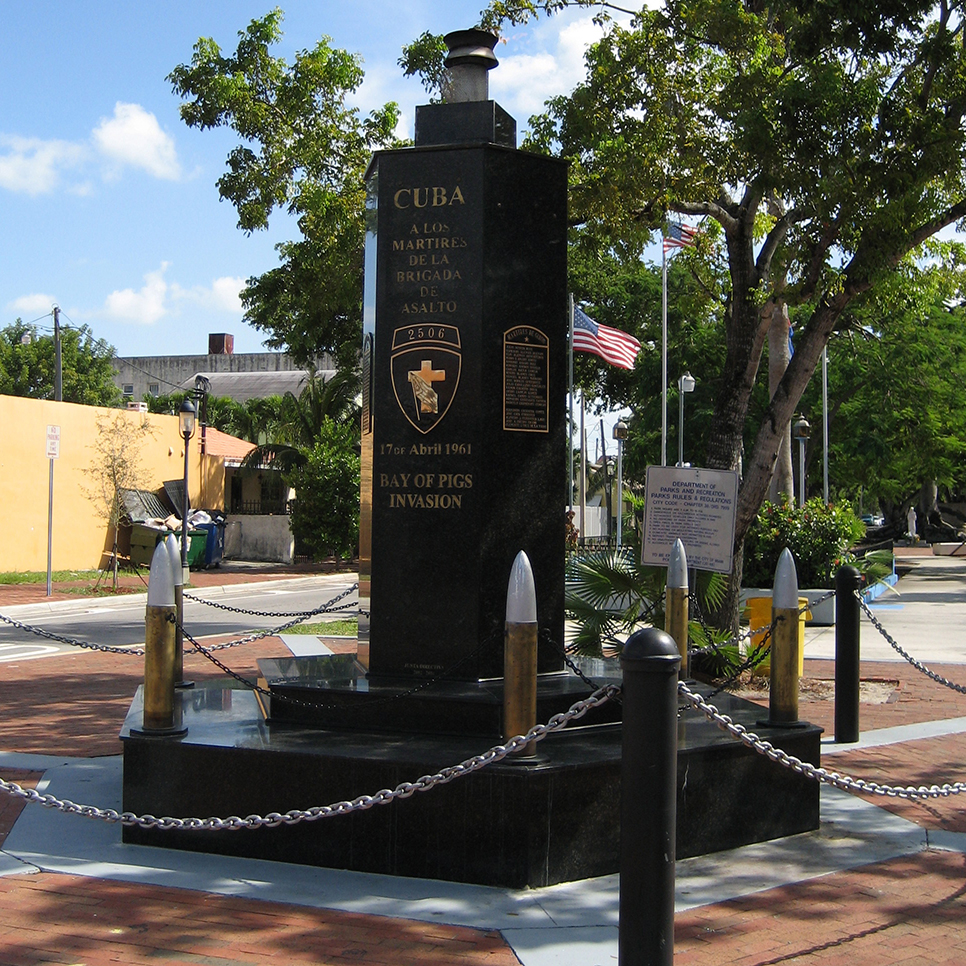
The Bay of Pigs Monument is a monument in honor of the fallen of the Bay of Pigs Invasion in Little Havana, Miami, Florida. On April 17, 1961, a group of Cuba exiles who opposed the government of Fidel Castro launched a landing operation, financed and directed by the U.S. government, near the Bay of Pigs on the southwestern coast of Cuba. The actual landing took place at Playa Girón in the vicinity of the Zapata swamps. The event is remembered in Cuba as the Invasión por Playa Girón.
The failed attempt attempt which lasted until April 20 has been repeatedly analyzed in the U.S. by academics, journalists, military experts, diplomats, and political figures. It has been variously called a "perfect failure," a "brilliant disaster," and so on. It served to increase the prestige of the Cuban government internationally. The debacle accelerated a closer relationship between Cuba and the Soviet Union and paved the way for the Cuban missile crisis of October 1962. During the October crisis the U.S. and the Soviet Union stood at the brink of nuclear war for 13 days, the most dangerous period during the Cold War.
The name Bay of Pigs, Bahía de Cochinos, was a reference not to actual pigs, but to a common colorful tropical fish called "cochino" very abundant in the area, also known as "pejepuerco" because their mouths resemble a pig's snout. Known in English as triggerfish.
Below a few links to articles and a video about the Bay of Pigs-Playa Girón invasion. -
Cuban War of Independence | February 24, 1895
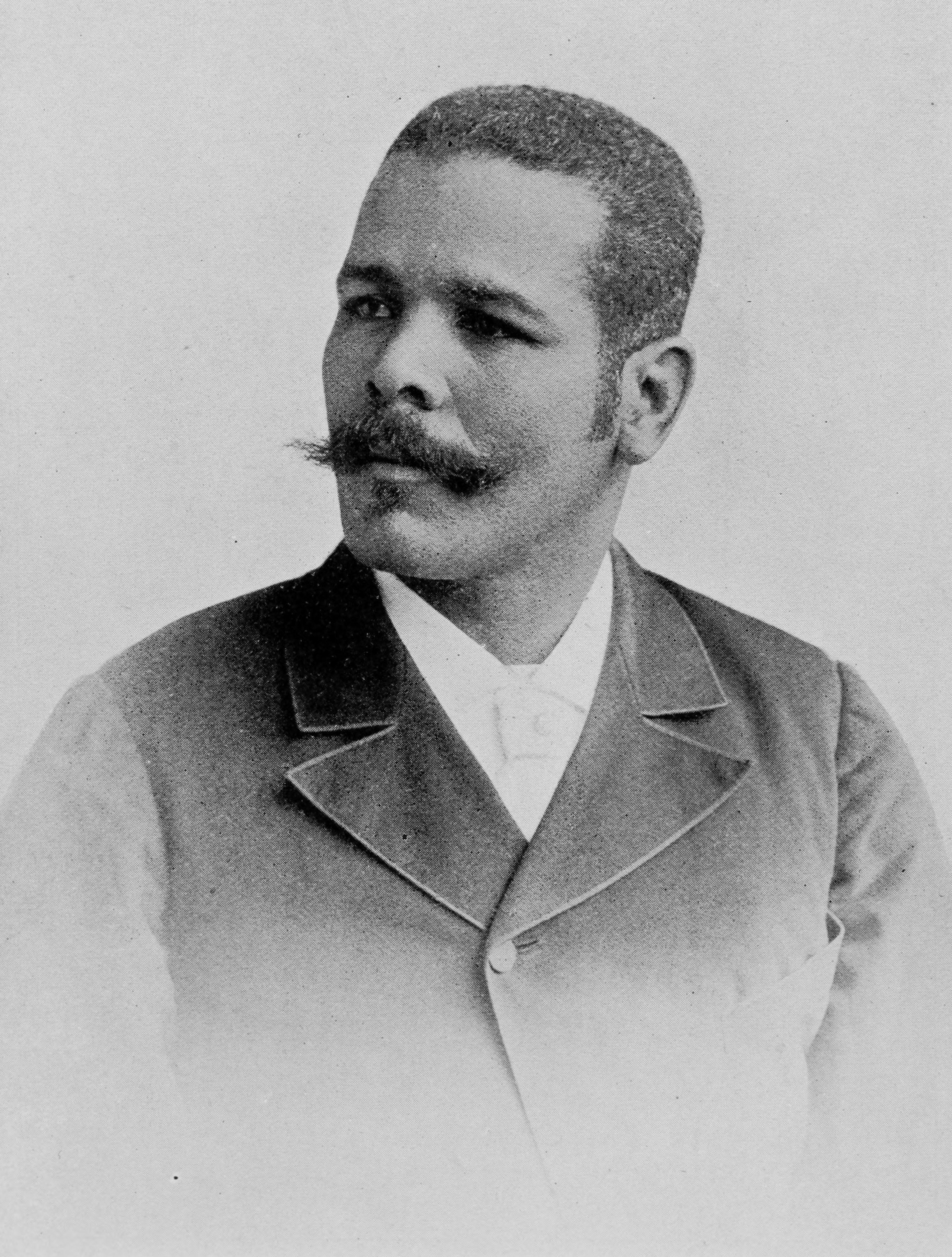
The Cuban War of Independence began in February 24, 1895, a national holiday in Cuba. The outstanding campaign of the war was the Invasion from East-West of the entire island led by the brilliant military leader General Antonio Maceo. An operation that covered 1000 miles in 96 days defeating many times technically and numerically superior forces of the Spaniards, the Invasion turned the entire Cuban countryside into pro-independence rebel territory.The troops under Maceo's command called him the "Bronze Titan" because of his exceptional physical strength and resistance to bullet or blade injuries. Maceo was killed in combat on December 7, 1896.
-
Today Jan 28th the birth of José Martí is celebrated in Cuba.
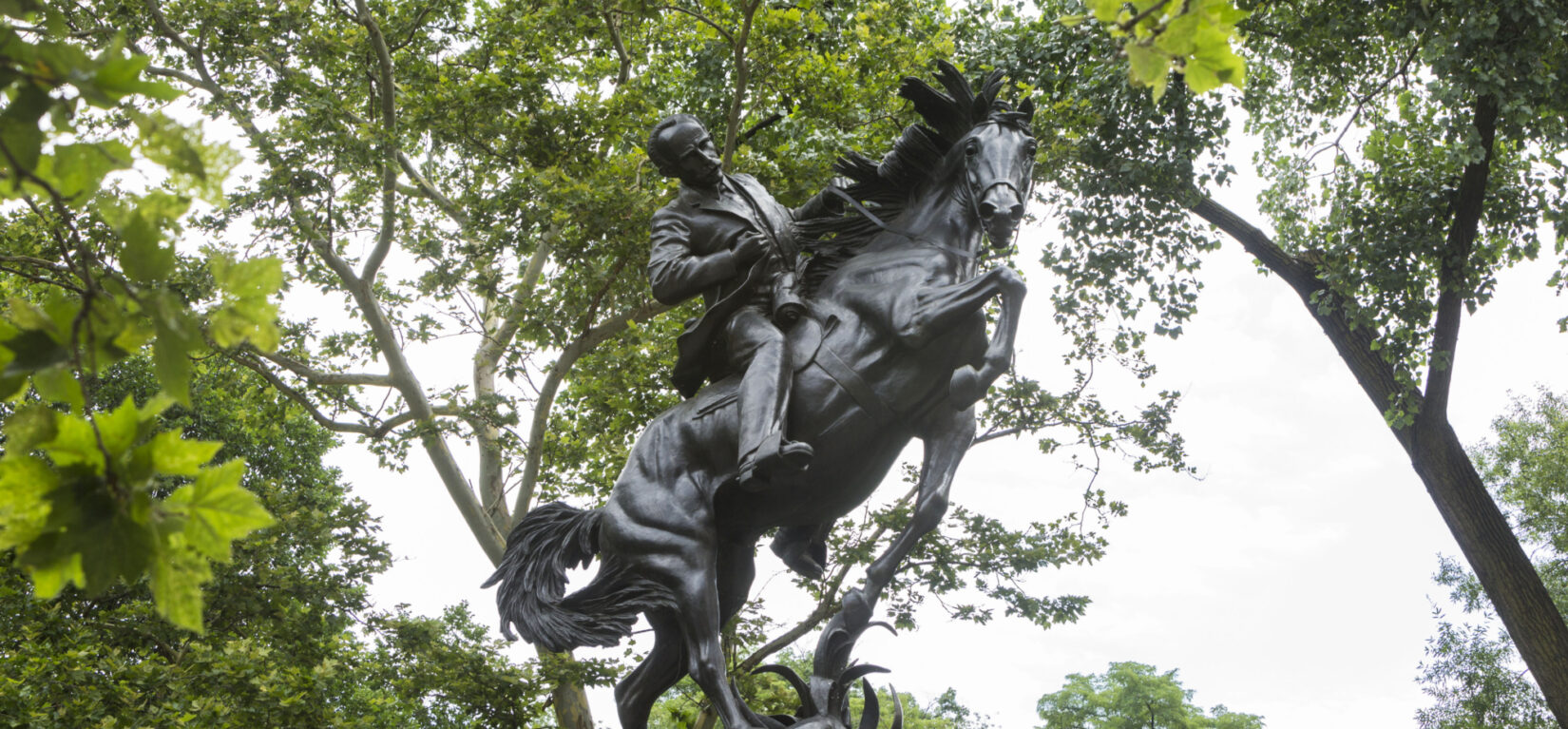
Photo by David Shankbone | Statue of José Martí in Central Park, New York City Independence activist, he was an eminent orator, poet, novelist, and literary critic. In New York, where he founded the Cuban Revolutionary Party, he wrote frequently for major newspapers in Latin America about life and events in the United States.
Martí was regarded by Guillermo Cabrera Infante as "one of the greatest writers in the Spanish language" and "a true original". Octavio Paz attributed to Martí the first ‘modernista’ poem that broke with poetic codes traditional in Spain. Lezama Lima and Cabrera Infante both considered Martí’s “Diario de campaña” the finest poem written by a Cuban poet.
-
Niagara Falls illuminated with the colors of the Cuban flag

On Jan 28, birth date of José Martí, Cuba's national poet and independence leader, Niagara Falls was illuminated with the colors of the Cuban flag: white, blue, and red.
Cuba has a special relationship with Niagara Falls since, in exile in the United States, the poet José María Heredia dedicated a poem exalted by the beauty of the natural break and longing for his homeland in the 1820s.
A bronze plaque with the image of Heredia and the verses of his "Ode to Niagara" remains located on a stone wall to one side of the waterfall, as a souvenir of his visit to the place.
-
108 Cuban Voices
Cuba has a centuries-old choral music tradition and its choirs are highly regarded around the world. An international choral festival is held every November in Santiago de Cuba.Recently choirs from several Cuban cities organized a virtual choral event bringing together 108 singers. The occasion was the celebration of 60 years of the foundation of the Orfeón Santiago by the celebrated arranger Electo Silva, and to honor Digna Guerra, for 45 years the Director of the Coro Nacional de Cuba. 108 Cuban voices interpret Silva’s arrangement of “Juramento,” a signature song by Miguel Matamoros, a Santiago musician considered a foundational figure of the son cubano. Link at the bottom.
In the time of Covid, choir members around the world can only rehearse and perform virtually. Each individual must control for light, background and sound, using whatever device available, i.e. laptop, cellphone, etc. Singing to a guide track, each participant records and uploads a video of their part, which often requires many “takes.” Next the video is mixed, mastered, synced, and edited together with the rest of the ensemble. Given the difficult conditions of internet and wifi access in Cuba, putting together this large virtual choir, is a considerable feat of art and technology.
-
Moving Beyond Words: Responding to Racialized Injustice in the United States.
- UC-Cuba Statement by Anita Casavantes Bradford
-
Caribbean Transnational Synergies II
2020 UC-Cuba Graduate Student Conference II (June 05, 2020)
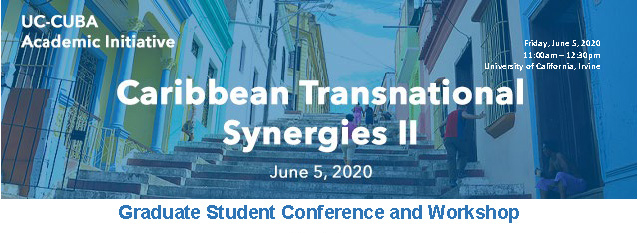
Click here to view the Conference Program | UC Cuba Statement by Anita Casavantes Bradford -
Life in the Time of COVID-19: The Poetics and Politics of Immobility in Haiti, the Dominican Republic and Cuba
Thursday, May 21 | 4:00-5:30pm PDT | Location: Zoom Video Conferencing
This panel discussion offers short presentations and discussion about the situation of Covid 19 in Cuba, Haiti and the Dominican Republic from the perspectives of three scholars with years of experience in these contexts.
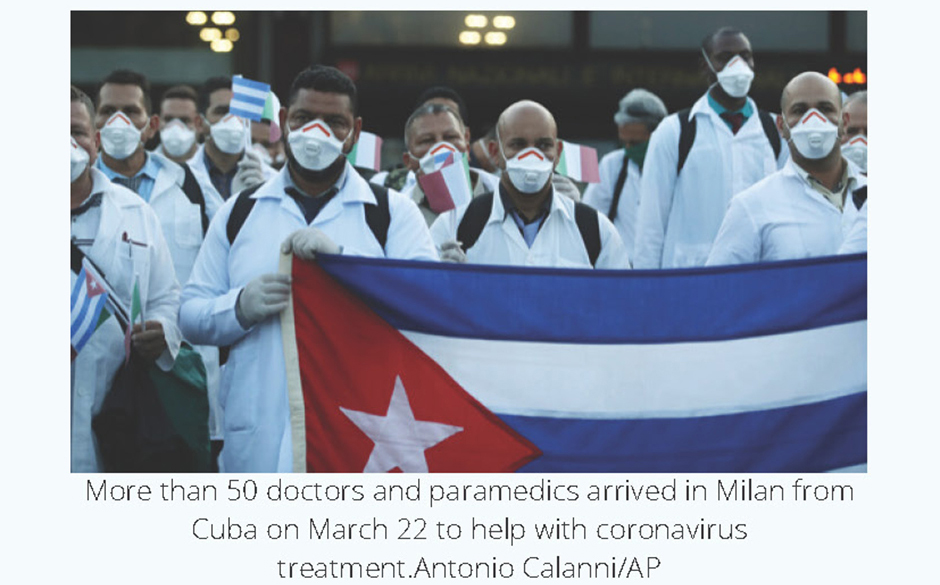
Presenters:
Join us at: https://ucla.zoom.us/j/92821059322
- Nancy Burke, Professor of anthropology and public health at University of California, Merced
- Dr. César Herrera, Director of CEDIMAT Centro Cardiovascular, Santo Domingo
- Rodrigo Bulamah, Post-doctoral fellow at the Graduate Program of Social Sciences, Federal University of São Paulo (Unifesp), Brazil
-
Caribbean Transnational Synergies
2020 UC-Cuba Graduate Student Conference and Workshop
-
A Musical Exchange Between New Orleans And Havana
-
Environmental historian Reinaldo Funes (University of Havana and Yale) will be visiting the Bay Area next week
-
Why Does Cuba Matter?
Monday, April 1 | 2:00 - 3:30 PM | COB2 - 392
Rafael J. Betancourt, Ph.D.
Professor of Urban Economics,Colegio Universitario, San Gerónimo de La HabanaAbstract: Recent transformations in the Cuban political and economic system form part of an alternative model of development to those currently existing in the region and other parts of the Global South. What are these main changes? What model of socialism is being crafted in Cuba and what are its perspectives? What can it contribute to other countries if it succeeds?
Biography: Consultant for Sol2 Economics, a progressive consulting firm based in Berkeley, California, and The Center for Responsible Travel (CREST), a non-profit organization devoted to increasing the positive global impact of responsible tourism. Professor Betancourt is the author of Construyendo socialismo desde abajo: La contribucion de la Economía Popular y Solidaria (Editorial Caminos, La Habana, 2017), and co-author, with Martha Honey, Jannelle Wilkins and José Luis Perelló, of Por el Mar de las Antillas: 50 años de turismo de cruceros en el Caribe (Ediciones Temas, La Habana, 2018). He has numerous published articles and is a frequent speaker in Cuba and the US on economics and tourism in Cuba. Born in Cuba and educated in the United States, he currently lives in Cuba and shares his time between the two countries.
Click Here to Download Flyer
-
MALPASO dance company
-
CUBAS LIVED & IMAGINED
UC-CUBA GRADUATE CONFERENCE - February 1, 2019 | UC Berkeley
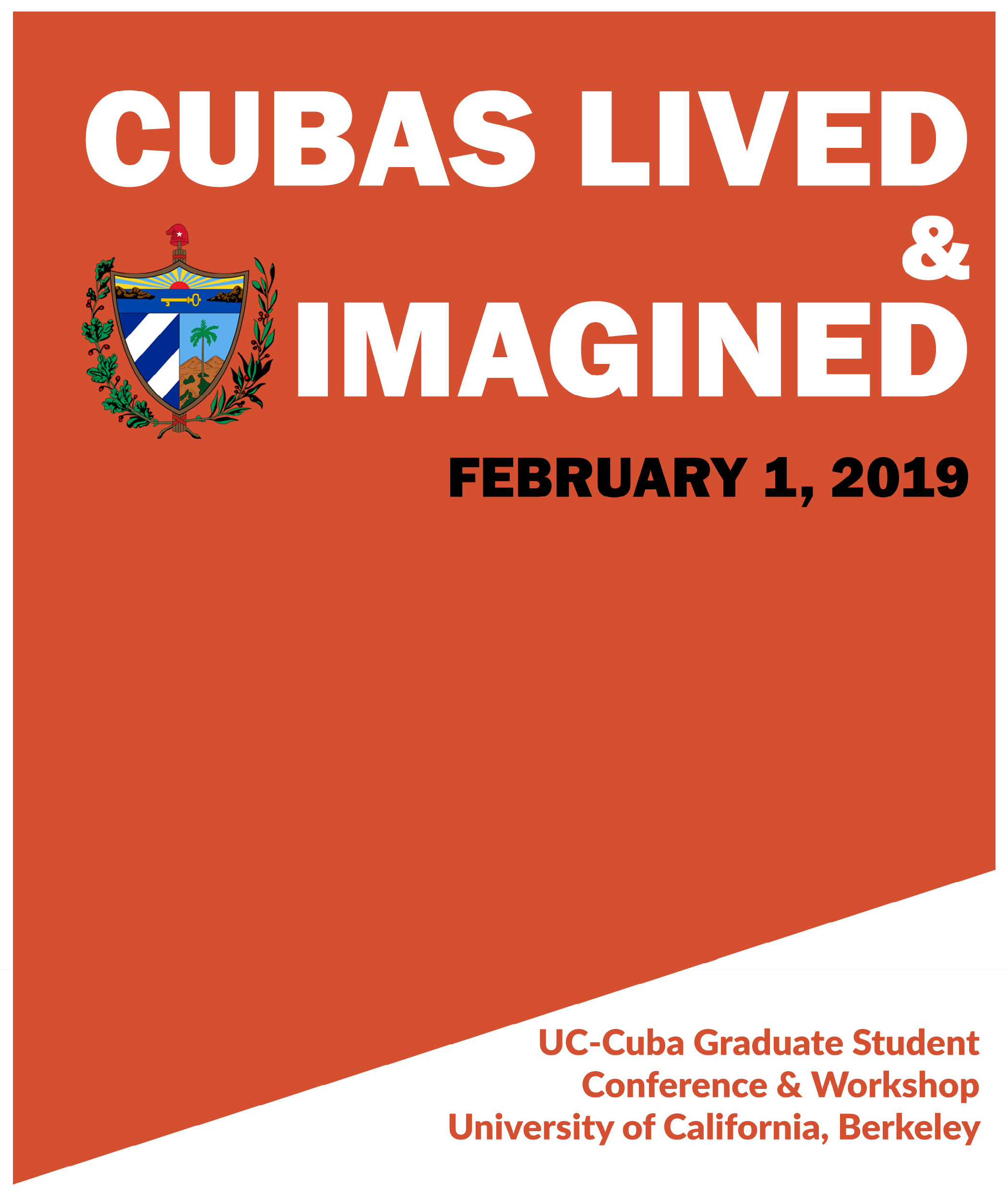
Click Here to Download Conference Program
-
Two major presentations by Leonardo Padura in Northern California
-
Screening followed by Q & A with Leonardo Padura and filmmaker Lucía López
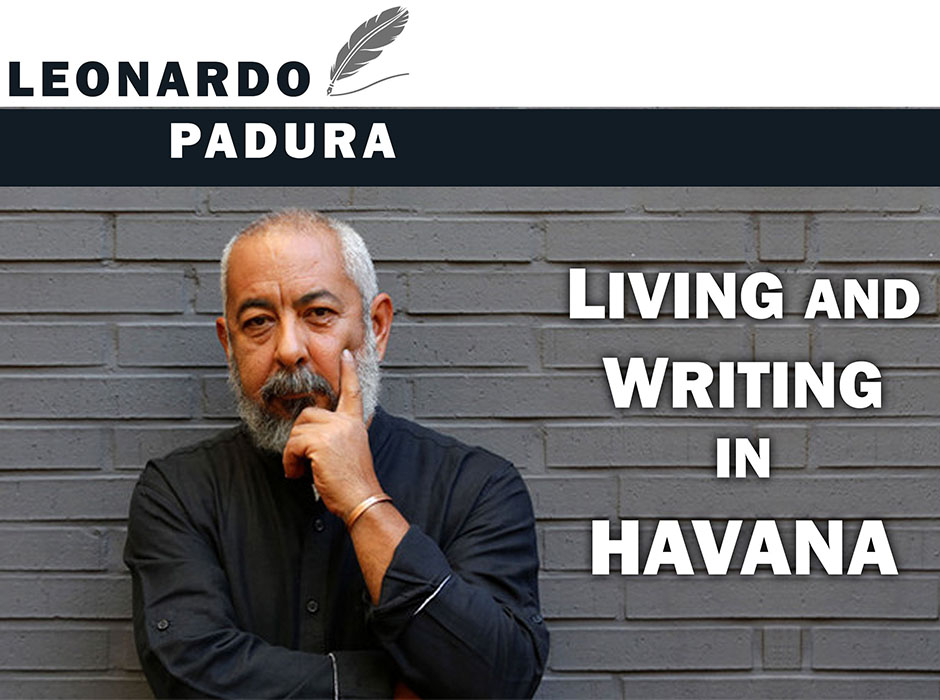
Living and Writing in Havana explores the connection of Leonardo Padura’s writing to the Cuban capital. The documentary also highlights the impressive reception his novels have in Cuba and the close relationship with readers through the iconic character Mario Conde.
When: October 4th
Time: 4:00pm
Location: McCormick Screening Room, Humanities
Preceded by a light reception 3:30 pm, Humanities Gateway Courtyard
sponsored by:
UCI School of Humanities,
School of Social Sciences and
UC-Cuba Academic Initiative -
Cuban Research Institute
Steven J. Green School of International & Public Affairs
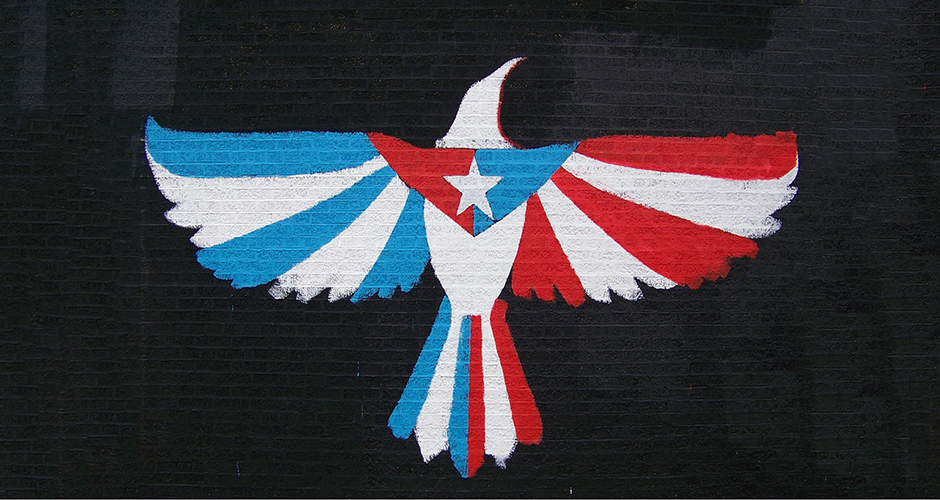
Call for Panels and Papers
Twelfth Conference on Cuban and Cuban-American Studies
Cuba and Puerto Rico: Two Wings of One Bird?
February 14–16, 2019The Cuban Research Institute (CRI) of Florida International University continues its tradition of convening scholars and other persons interested in the study of Cuba and Cuban Americans by announcing its 12th Conference. We encourage the submission of panels and papers concentrating on any aspects of the main conference theme, but will consider all submissions relevant to the history, economy, politics, culture, society, and creative expression of Cuba and its diaspora.
In 1893, the Puerto Rican poet Lola Rodríguez de Tió (1843–1924) published her patriotic text, "To Cuba." In this poem, she wrote: "Cuba and Puerto Rico are / two wings of one bird / they receive flowers or bullets / in the same heart." Generations of Cubans and Puerto Ricans have recited these verses as an expression of the solidarity between the two peoples and their shared cultural traditions. Arawak peoples inhabited both islands before their Spanish conquest and colonization beginning in the late 15th century. Cuba and Puerto Rico remained the last Spanish colonies in the Americas until 1898, when U.S. troops invaded the islands.
Whereas Cuba attained its formal independence in 1902, Puerto Rico became an unincorporated territory of the United States. U.S. political, economic, and cultural influence was pervasive in the two Antilles during the first half of the 20th century. Puerto Rico became a U.S. Commonwealth in 1952, but the United States broke diplomatic relations with Cuba in 1961, after the triumph of the 1959 Cuban Revolution. For several decades during the Cold War, Cuba and Puerto Rico represented countermodels for economic and political development.
The Twelfth Conference on Cuban and Cuban-American Studies takes Rodríguez de Tió's famous metaphor of the "two wings of one bird" as a cue for comparative academic inquiry and public debate. Our main theme, the relations between Cuba and Puerto Rico, invites interdisciplinary approaches to the multiple, complex, and often contrasting links between the two countries, both historically and in current times. Although we welcome discussions about the recent situation and the future of Cuba and Puerto Rico, we invite a thorough retrospective examination of the social, economic, political, and cultural dimensions of the intertwined histories of the two countries. We are especially interested in assessing the contribution of the islands' diasporas to the growing "Latinization" of the United States, particularly in Florida.
-
Research Travel Grants
Published: March 10, 2018
The UC-CUBA Academic Initiative will award up to six $1,500 research and travel grants to University of California graduate students conducting Cuba-related research in any field. Preference will be given to first-time proposals for initial research explorations, and for completing advanced projects.
Interested applicants should submit a brief (2-page maximum) statement that outlines the project and explains how it advances their planned course of study or dissertation completion, accompanied by a budget, a short CV, and a letter evaluating the project from the applicant's adviser. Those receiving the awards will be expected to present their work at a UC-CUBA seminar in early 2019.
Please submit your proposals and any questions to hanna.garth@gmail.com
The deadline for submission of proposals: April 15, 2018. Awards will be announced by May 1, 2018.
-
Report on UC-CUBA Academic Initiative Trip to Santiago de Cuba and Holguín
Published: December 12-19, 2017
Office of City Curator, Santiago de CubaUC-CUBA Co-Director Nancy J. Burke (UC Merced) and Professor Emeritus and Executive Secretary Raul Fernandez (UC Irvine) traveled to Cuba from Dec 12-19 to conduct research and explore new avenues for scholarly and cultural collaboration. Professors Burke and Fernandez visited several academic and cultural centers in Santiago and Holguín. In Santiago they visited the Curador de la Ciudad Office1, the Emilio Bacardí Museum, the Museo de la Lucha Clandestina, the Casa de las Tradiciones, the Loyola Center, the Patio Artex, the Casa de la Trova, the Casa Velázquez, and the Casa del Caribe. At Casa del Caribe, Professors Burke and Fernandez viewed Casa’s collection of Afro-Cuban religious artifacts, discussed the religious lineage of the institution and reflected on the UC graduate students, most notably UC Cuba alum and now-UCSD Assistant Professor Hana Garth, who have worked with Casa.
It has been four years since Hurricane Sandy devastated much of the city of Santiago de Cuba. Professors Burke and Fernandez made an informal assessment of current economic and social conditions in the city and evaluated potential accommodations for UC-CUBA graduate student researchers. They noted improvements in the marina area2 and toured restored areas of the city, in particular the complete refurbishment of the famed Santa Ifigenia Cemetery which now includes the Fidel Castro’s burial vault. They also observed the transformation of the city’s main commercial area into a pedestrian zone, and the development for tourism of the areas surrounding the majestic San Pedro de la Roca (El Morro) Castle. Finally, they assessed the conditions of emblematic sites including the city’s Cathedral and historic San Juan Hill.
In order to advance his current research, Professor Fernandez met with members of the son musical ensembles La Familia Valera Miranda and la Orquesta Típica de Santiago de Cuba. Both Professors Burke and Fernandez met with Mr. Pérez Ung, a noted local radio music programmer, to discuss a range of topics related to issues of cross-cultural communications.
In Holguín Professors Burke and Fernandez visited the the University of the Arts (ISA-Filial Holguín) and Union of Writers and Artists of Cuba (UNEAC).
Professors Burke and Fernandez were welcomed at the ISA Holguín by Linguistics Professor Orlando Cedeño; they gave a short colloquium to a group of faculty and students. Cuban faculty members expressed great interest in Professor Fernandez’s publications on Cuban Jazz, and the colloquium included a lively interchange about Cuban popular music, including the contemporary rock-and-roll movement in Holguín. Professors Burke and Fernandez held several additional consultations with Professor Cedeño, who educated them on the history of opera in Holguín, including current productions and training opportunities.
At the Union of Writers and Artists of Cuba (UNEAC) Burke and Fernandez met with Director Manuel Pérez González to discuss how to nurture future relations between the Union and UC Cuba.
Finally, as part of her ongoing research on health and aging in Cuba, Professor Burke met with older adults struggling with caregiving responsibilities for elderly family members, as well as several undergoing advanced stages of cancer treatment. Through ISA Professor Orlando Cedeño, Burke also established new contacts with a gastroenterologist and an endocrinologist, continuing to expand her network of key informants on the Cuban healthcare system.
Co-Director and Professor, Nancy J. Burke, UC Merced
Co-Director and Professor, Anita Casavantes Bradford, UC Irvine
Associate Director and Professor, Hanna Garth, UC San Diego
Secretary and Professor Emeritus, Raul Fernandez, UC Irvine-----------------------------
-
8th UC-CUBA Graduate Student Conference at UC Irvine
-
UC-Cuba Statement on DACA
Published: September 8, 2017
Between 1959 and 1965, hundreds of thousands of Cubans fled political instability, repression, violence and material deprivation in their homeland. Under three consecutive US presidents, they benefited from executive actions that allowed them to live and work in the United States without immigrant visas and that provided millions of federal dollars for their resettlement, healthcare and education. In 1966 Congress acted to regularize the immigration status of these Cubans, most of whom had entered the US as "parolees" or on long-since expired tourist visas. The Cuban Adjustment Act granted these parolees and visa overstayers permanent resident status and provided them with an expedited path to US citizenship--though most of them declined to become citizens until the 1980s.
The recent decision to rescind the Deferred Action for Childhood Arrivals (DACA) executive action that has provided temporary stays of deportation and work authorization to more than 800,000 undocumented young people--whose families have similarly fled political instability, repression, violence and material deprivation in their own home nations--has been justified by some as a corrective to an unprecedented and potentially unconstitutional overreach of executive power.
Today's Cuban American community owes its origins to just such an exercise of executive power.
As scholars of Cuba and its diaspora, we are not qualified to evaluate the constitutionality of these immigration-related executive actions. We nonetheless feel compelled to point out that they are not without precedent. Moreover, the history of the now prosperous Cuban American community, which has contributed so much to the social, cultural and economic life of the US, is just one example of the ways that our nation has benefited from the careful exercise of executive power to facilitate the integration of undocumented immigrants in our society.
The more recent history of DACA-mented youths' educational and professional accomplishments, their unwavering record of community engagement and desire to assume the full responsibilities of citizenship, provide further proof of the ways that executive action on behalf of unauthorized immigrants has enriched our national life.
As they did with the 1966 Cuban Adjustment Act, it is time for Congress to pass legislation allowing the 800,000 plus DACA-mented youth--as well as their hard-working, law-abiding undocumented family members--to regularize their immigration status and to live among us without fear, as equal members of the communities to which they have already contributed so much.
Anita Casavantes Bradford,
Ph.D. Co-Director, UC Cuba Academic Initiative
Associate Professor, Chicano/Latino Studies and History
University of California IrvineUniversity of California sues Trump administration on unlawful repeal of DACA program
UC Office of the President
September 8, 2017
Text Area
Main Content
Content Section Two
Content Section Three
Content Section Four
Content Section Five
© UC Irvine School of Social Sciences – 3151 Social Sciences Plaza, Irvine, CA 92697-5100 – 949.824.2766




